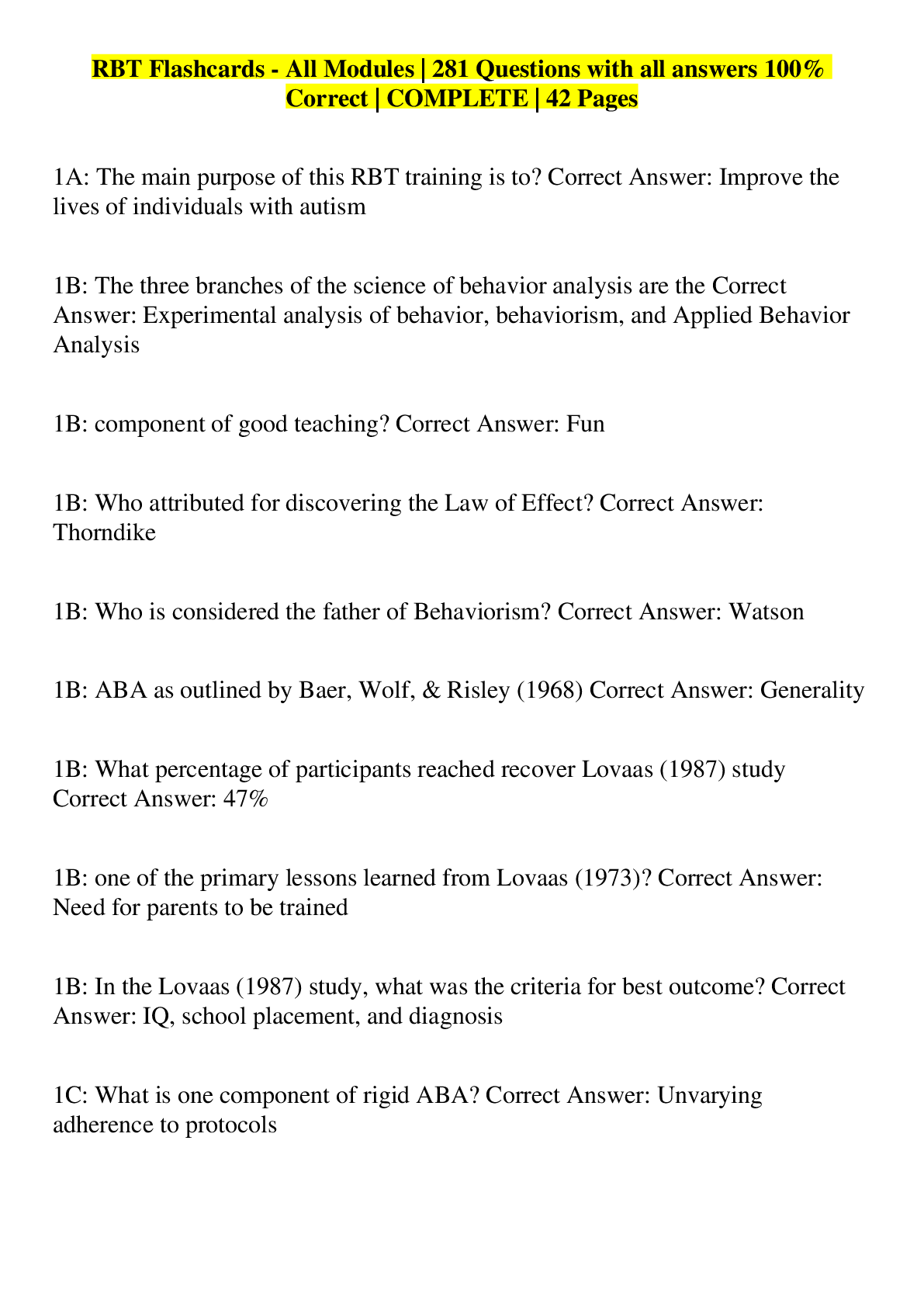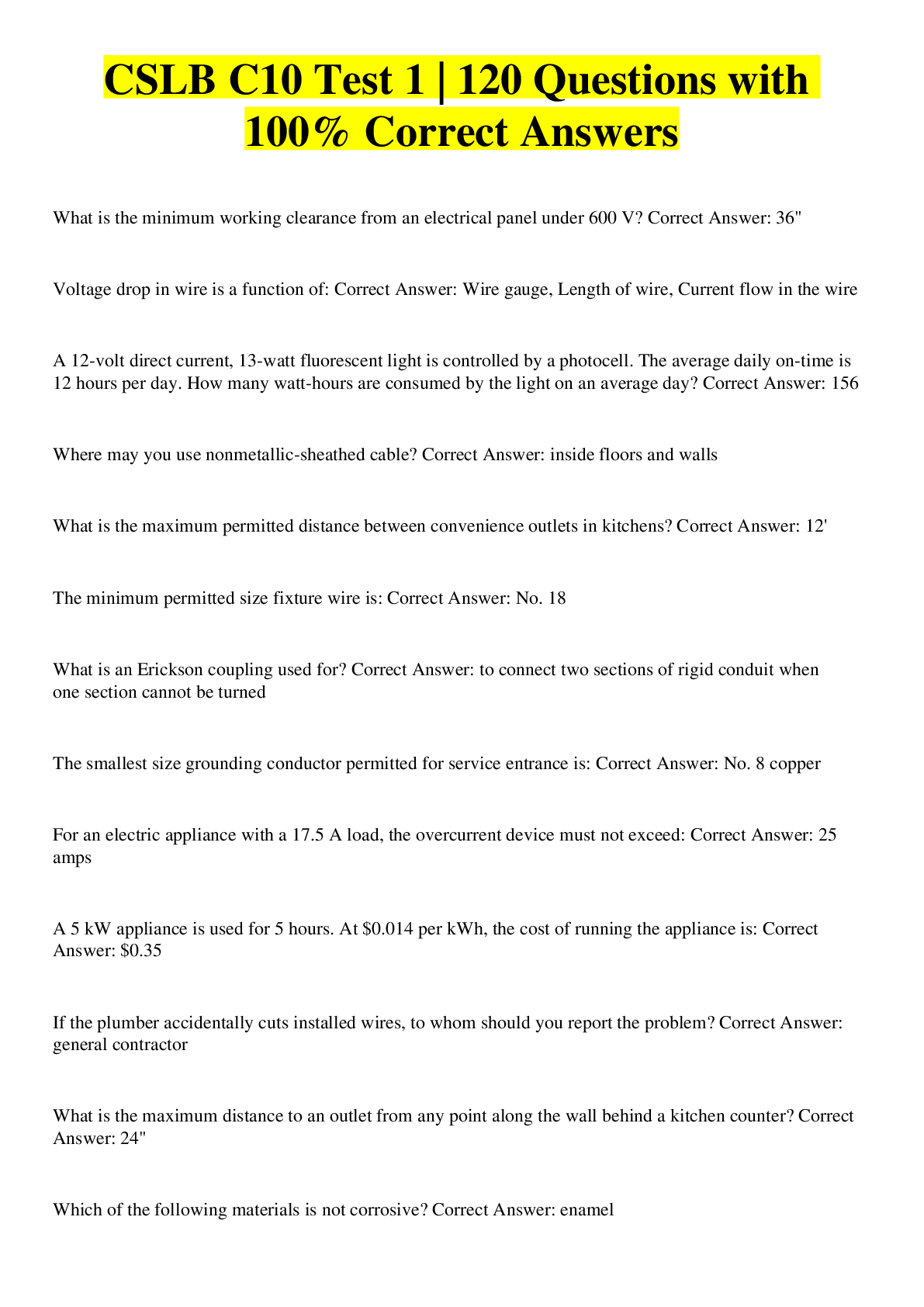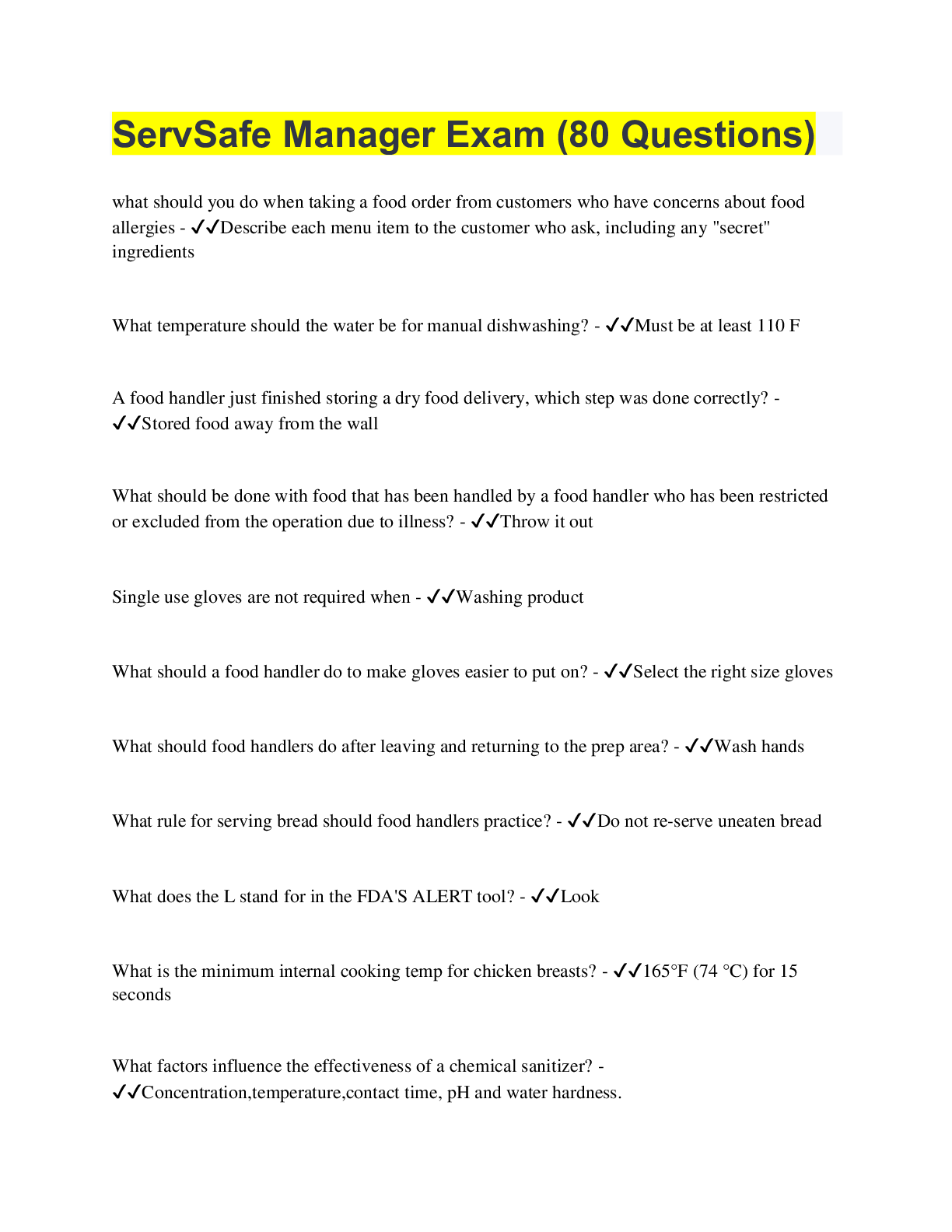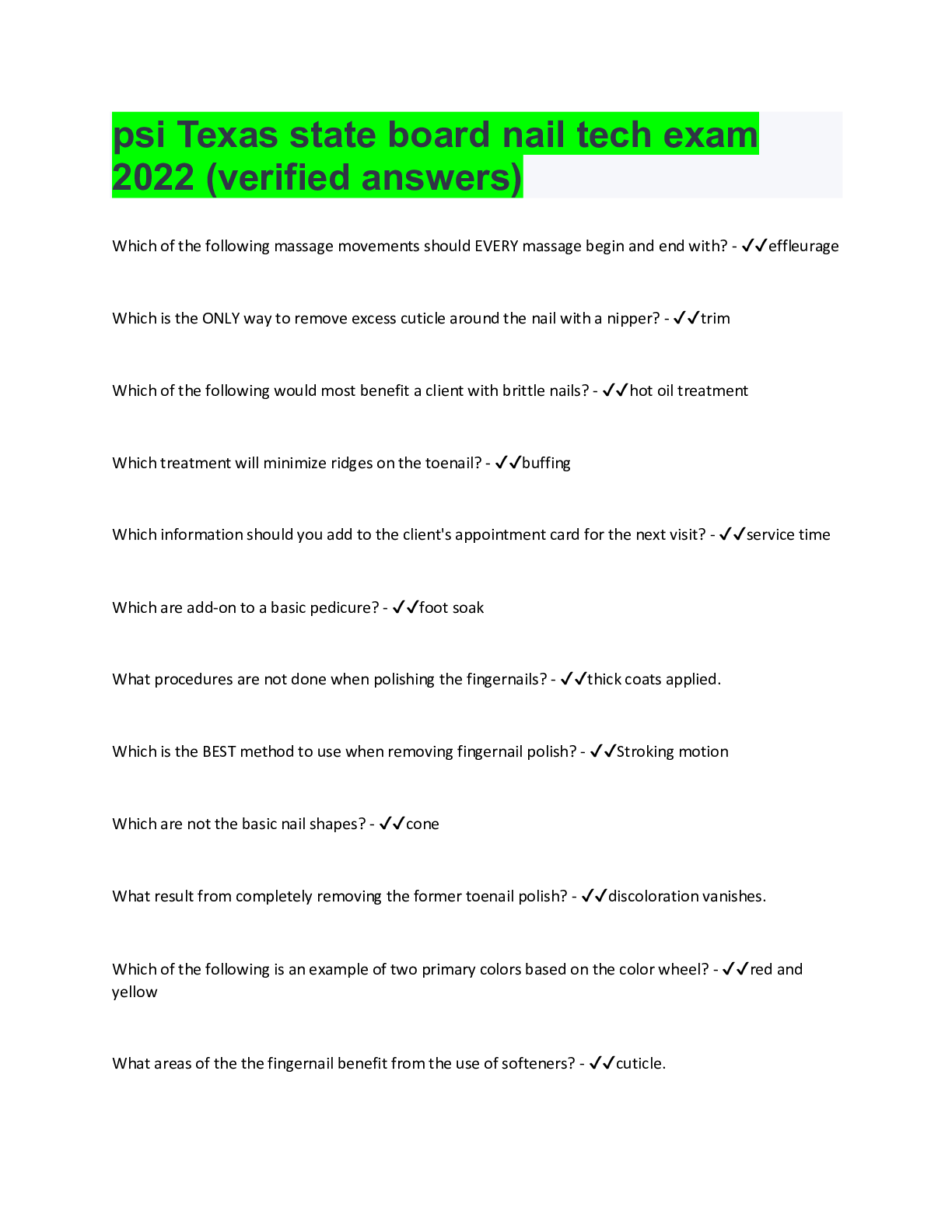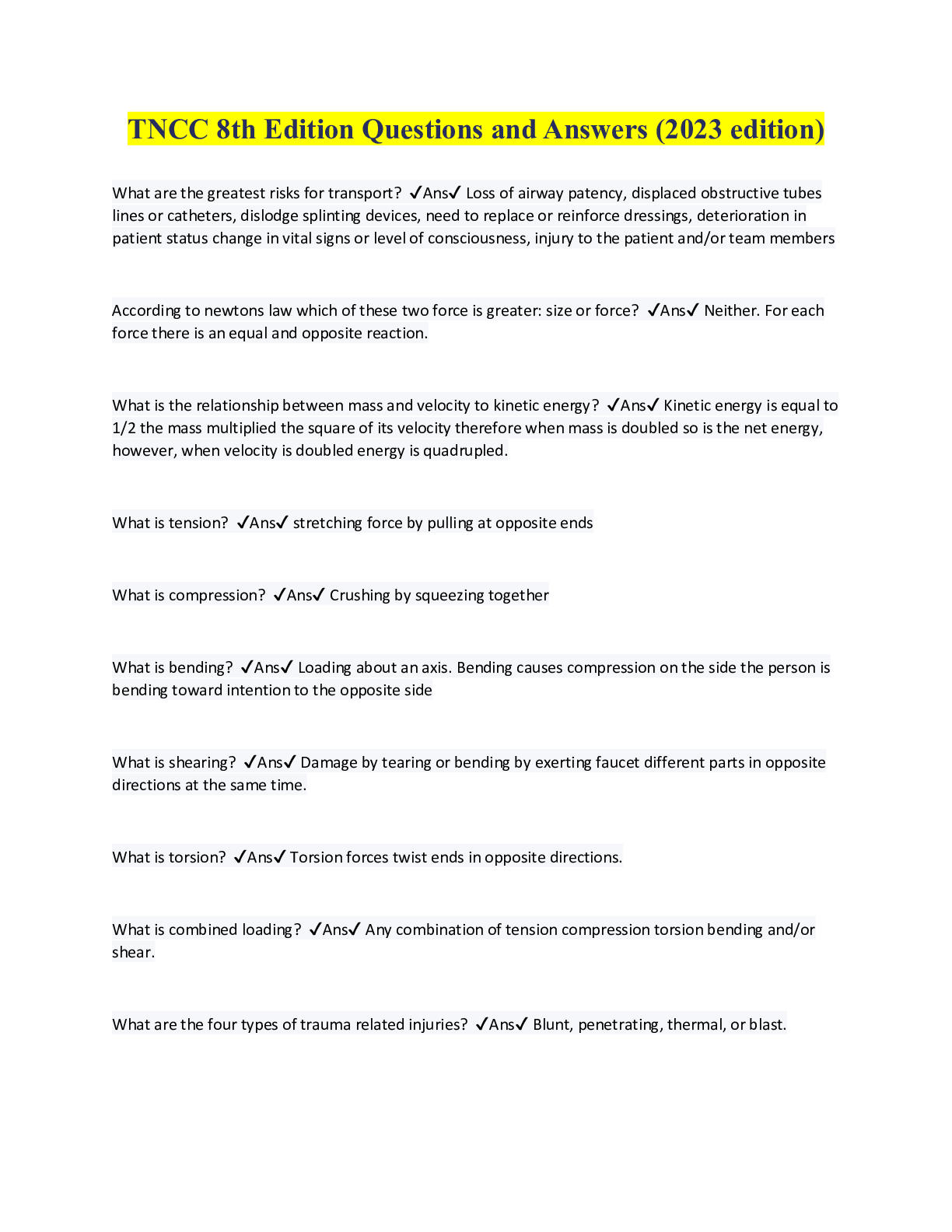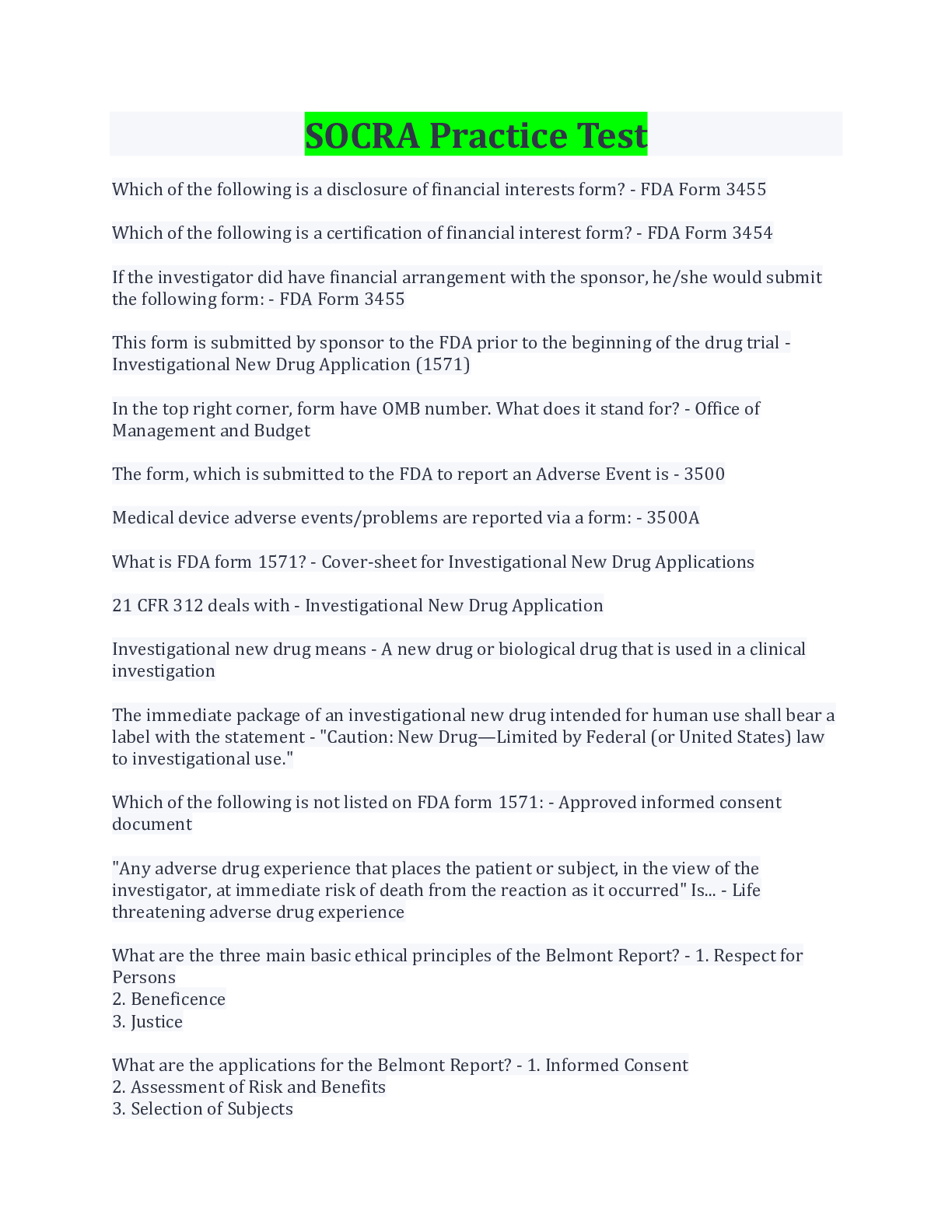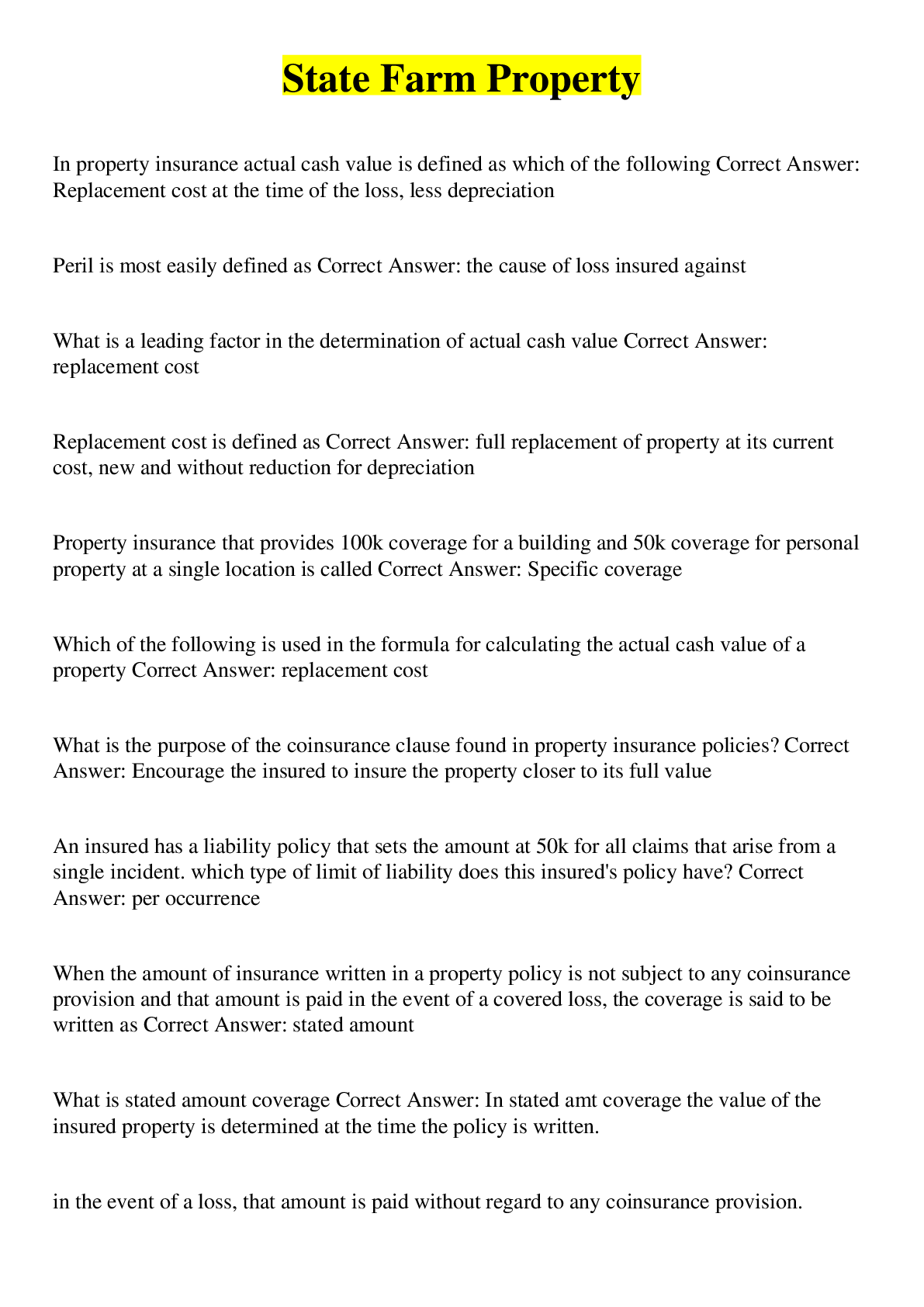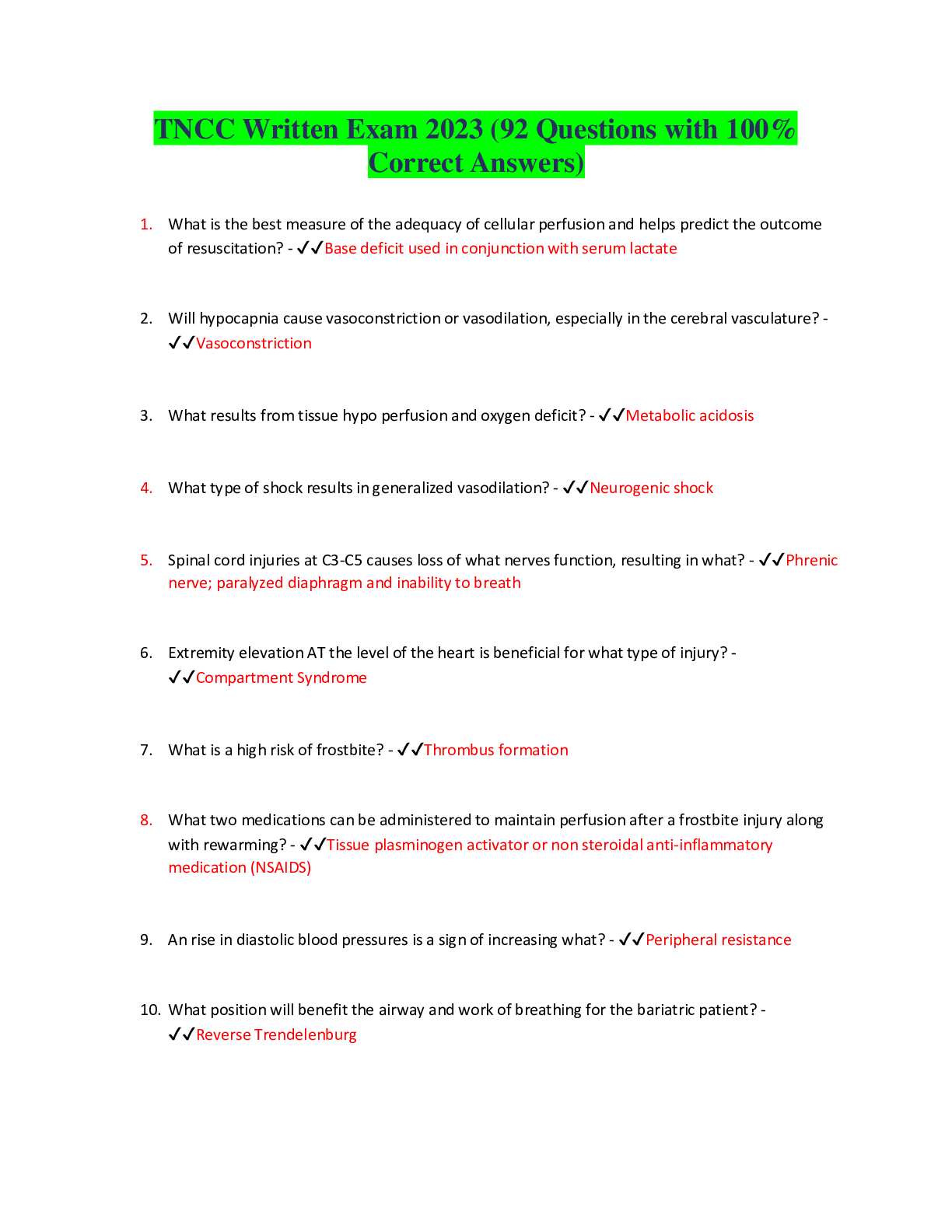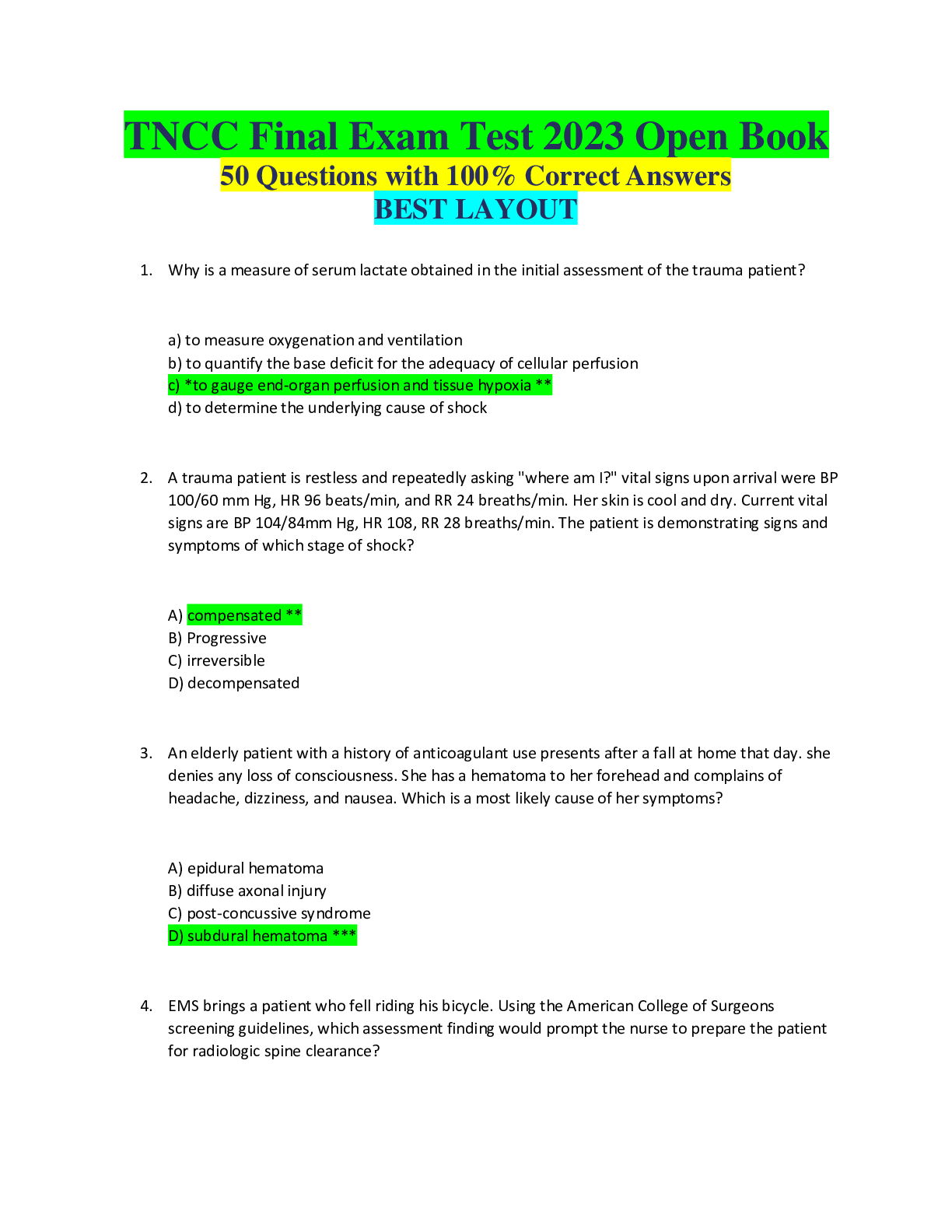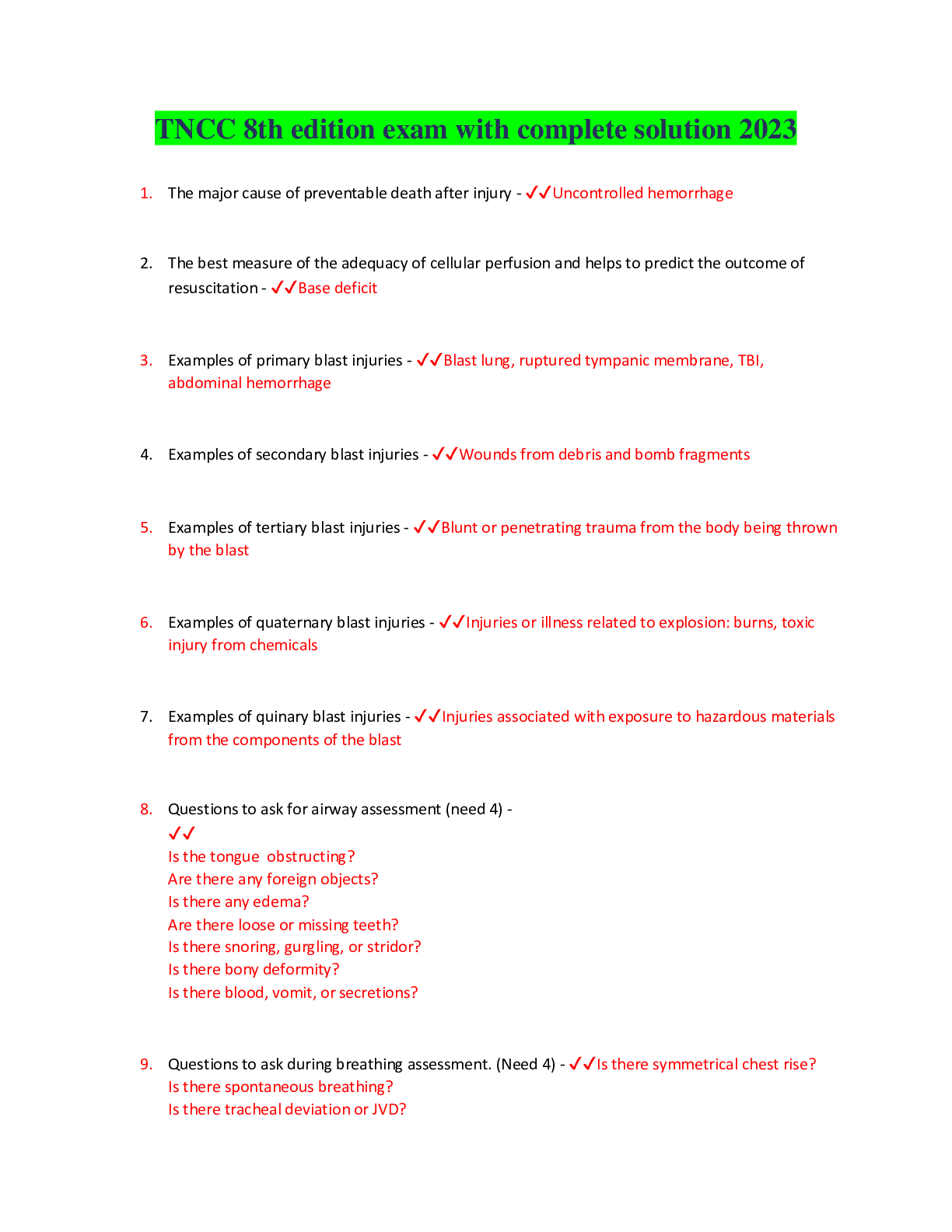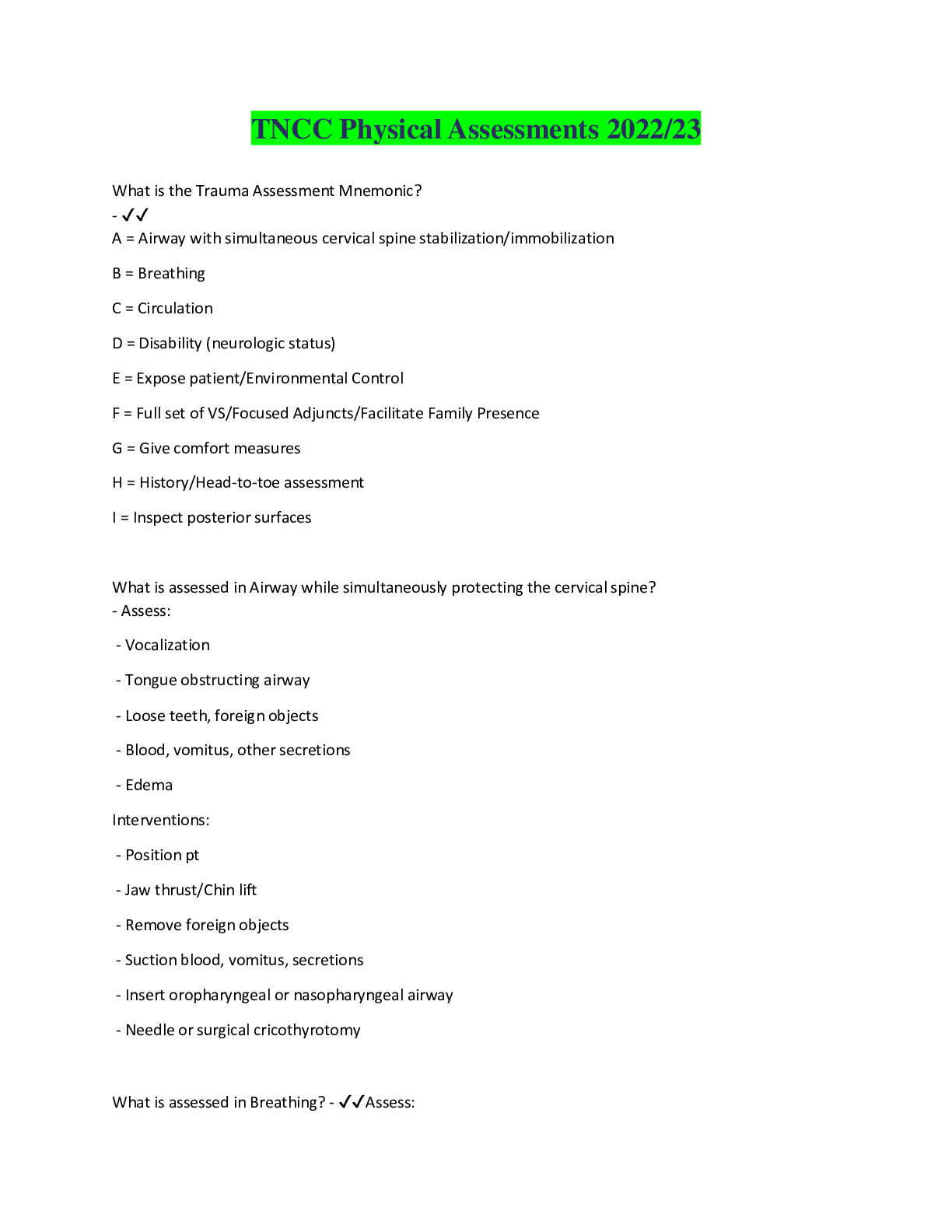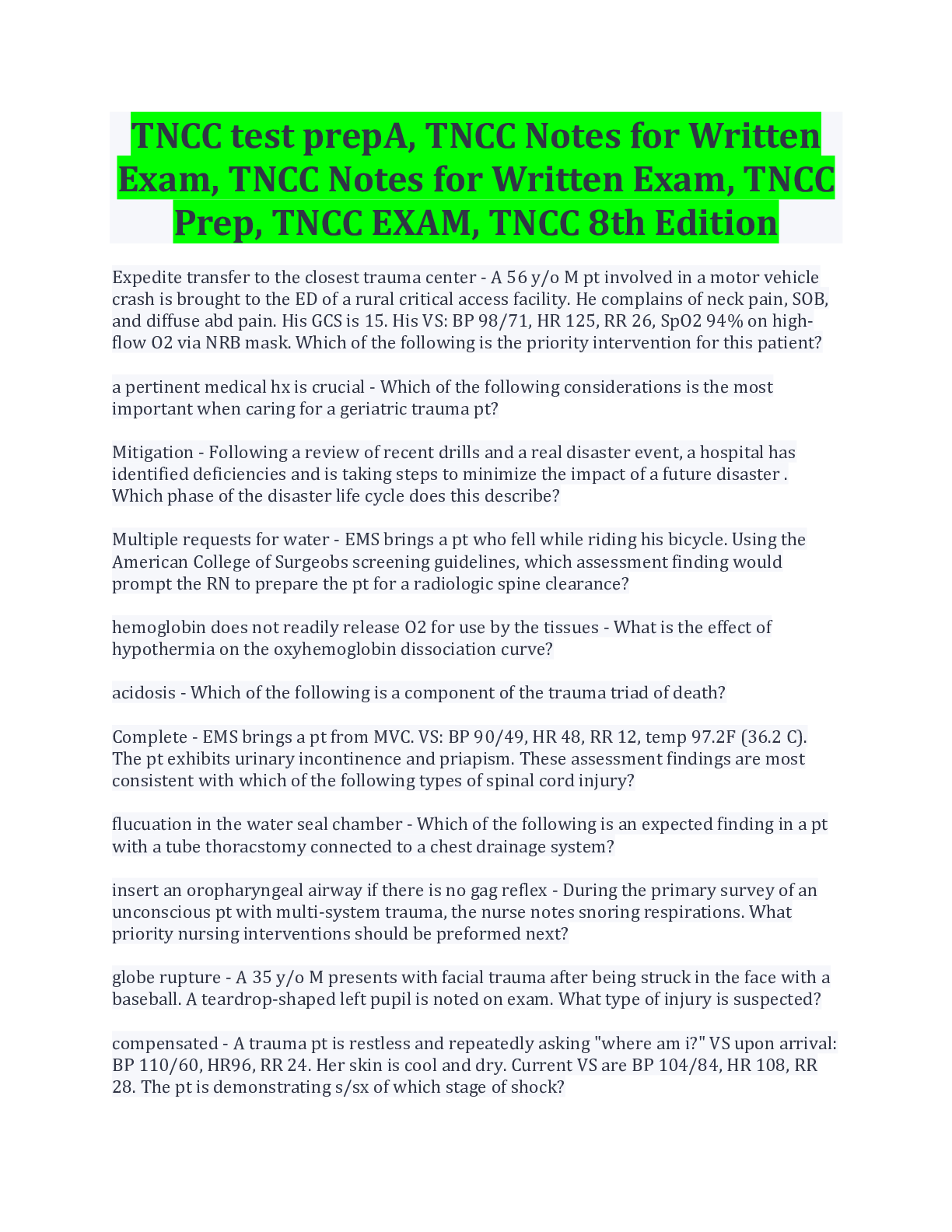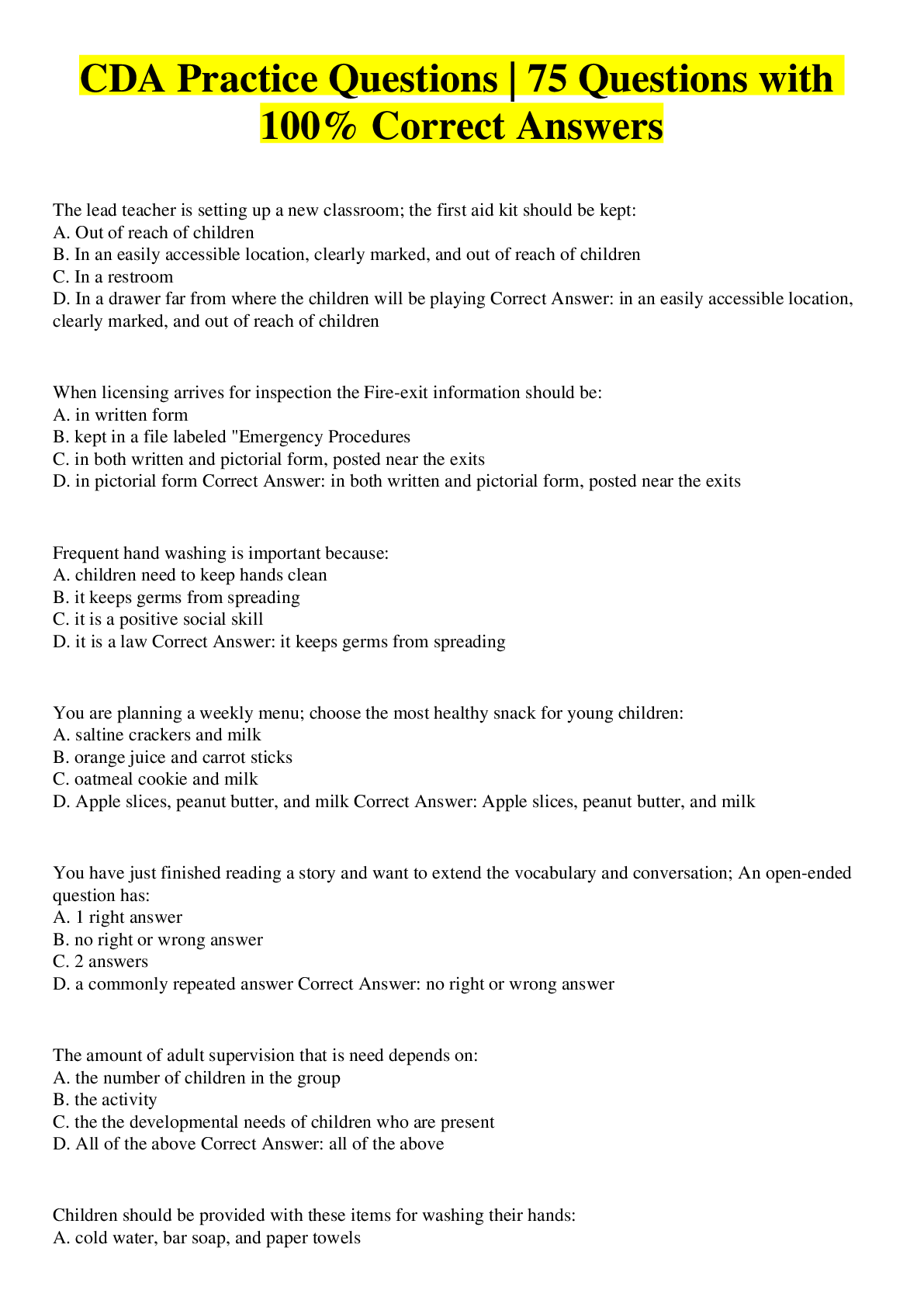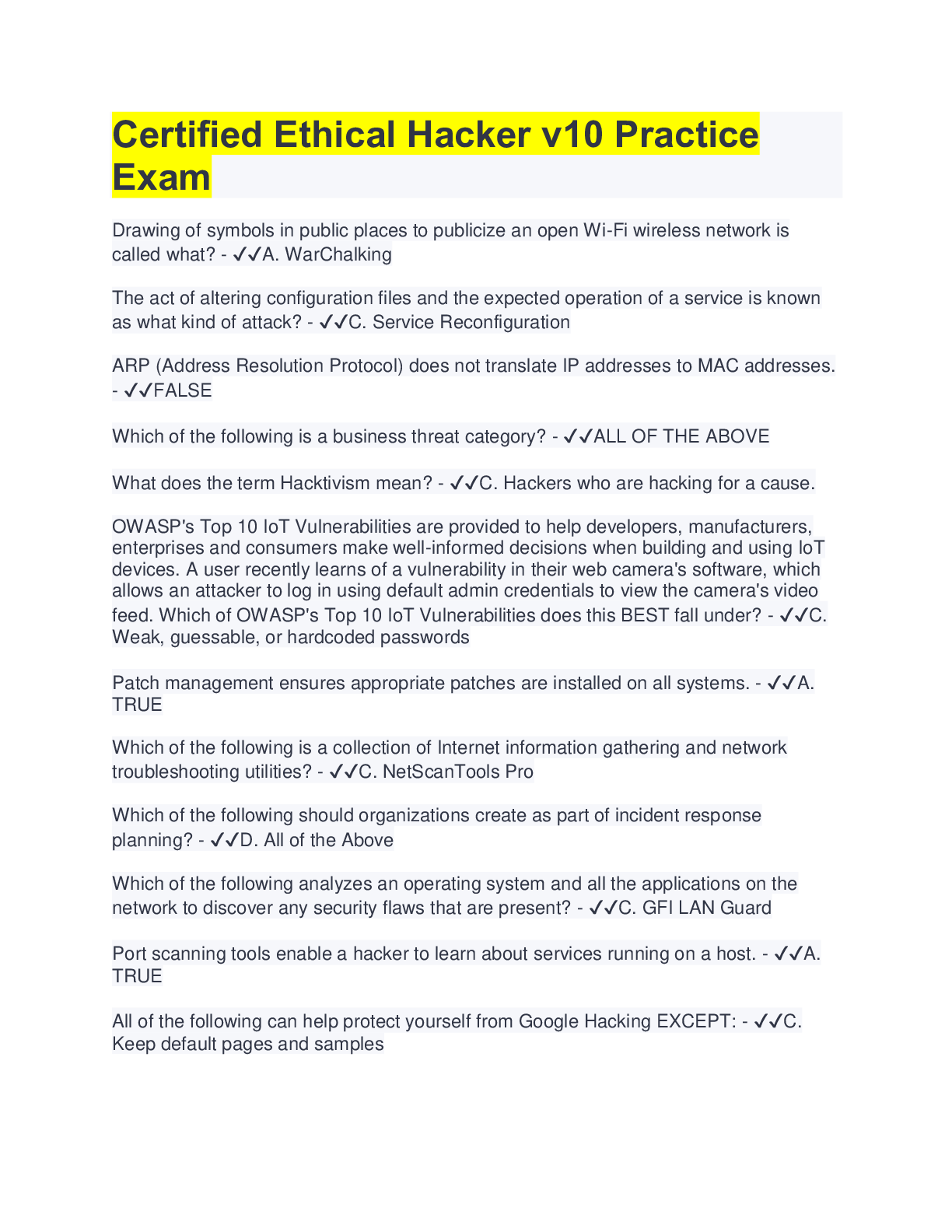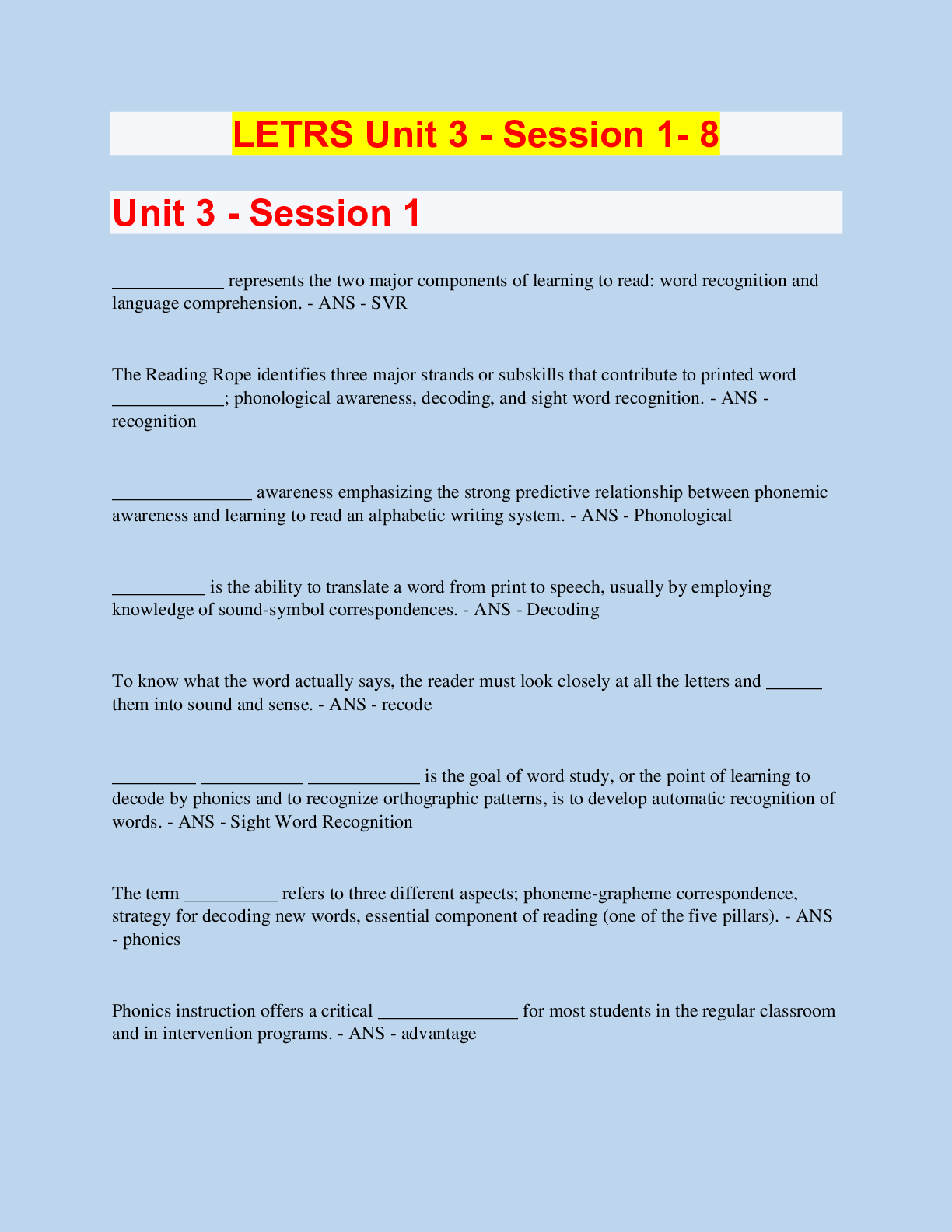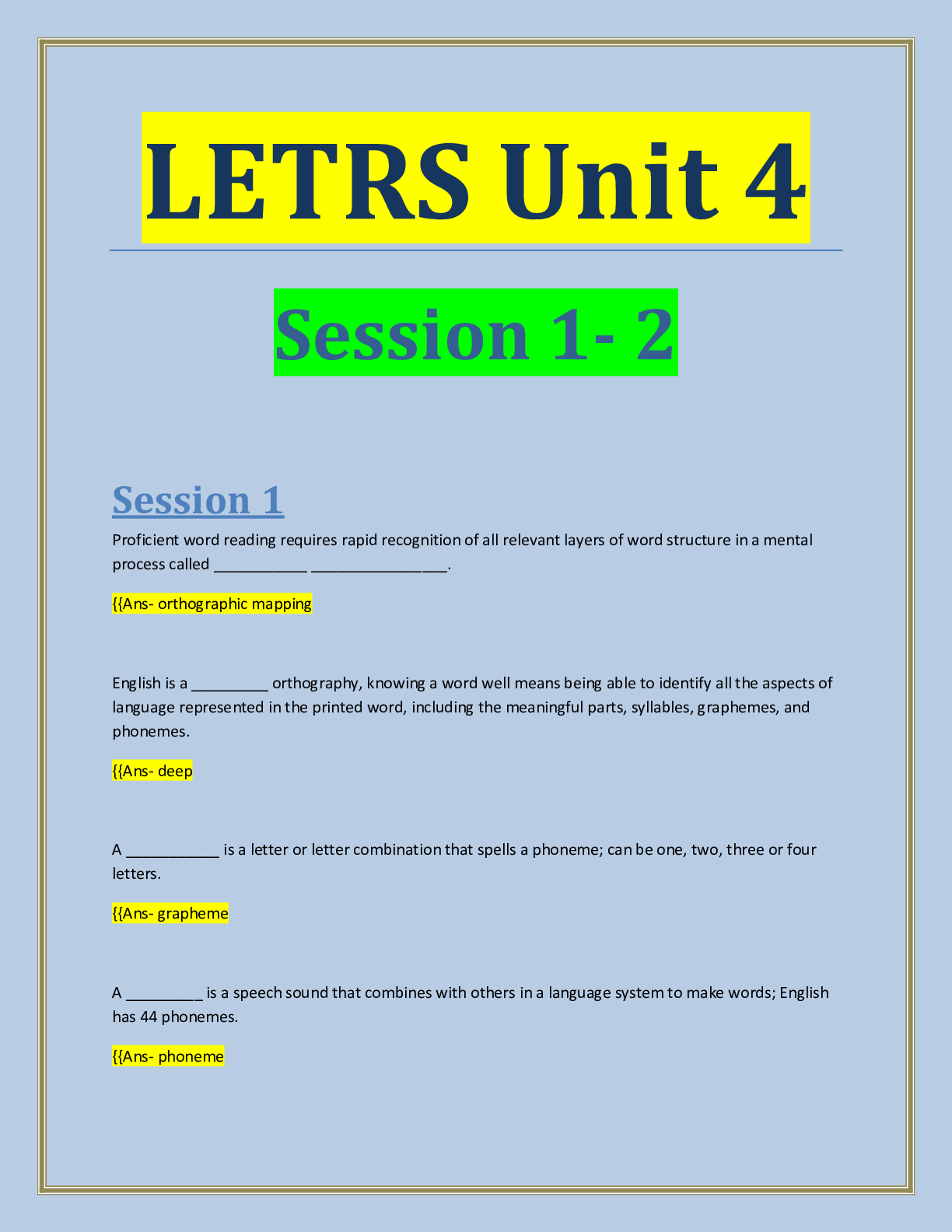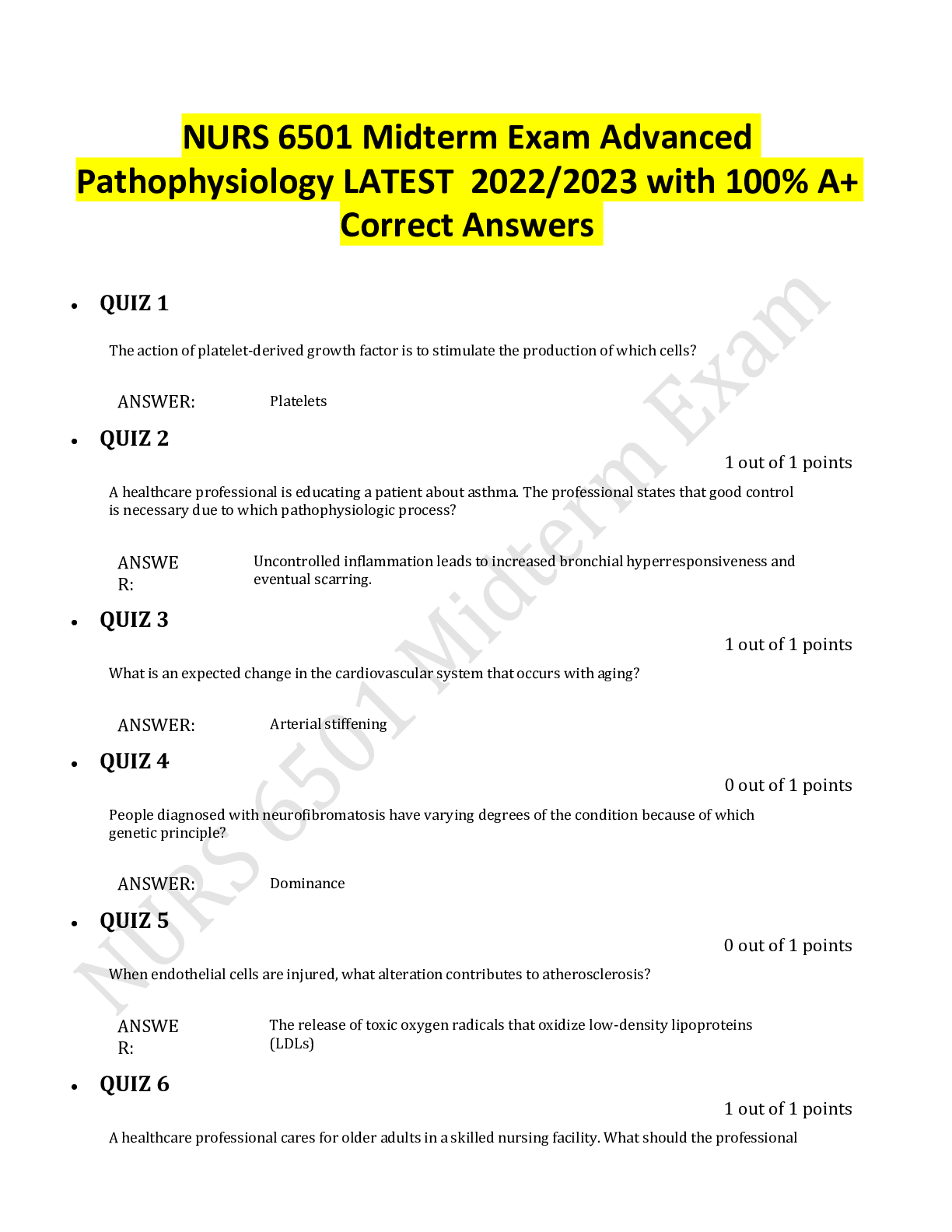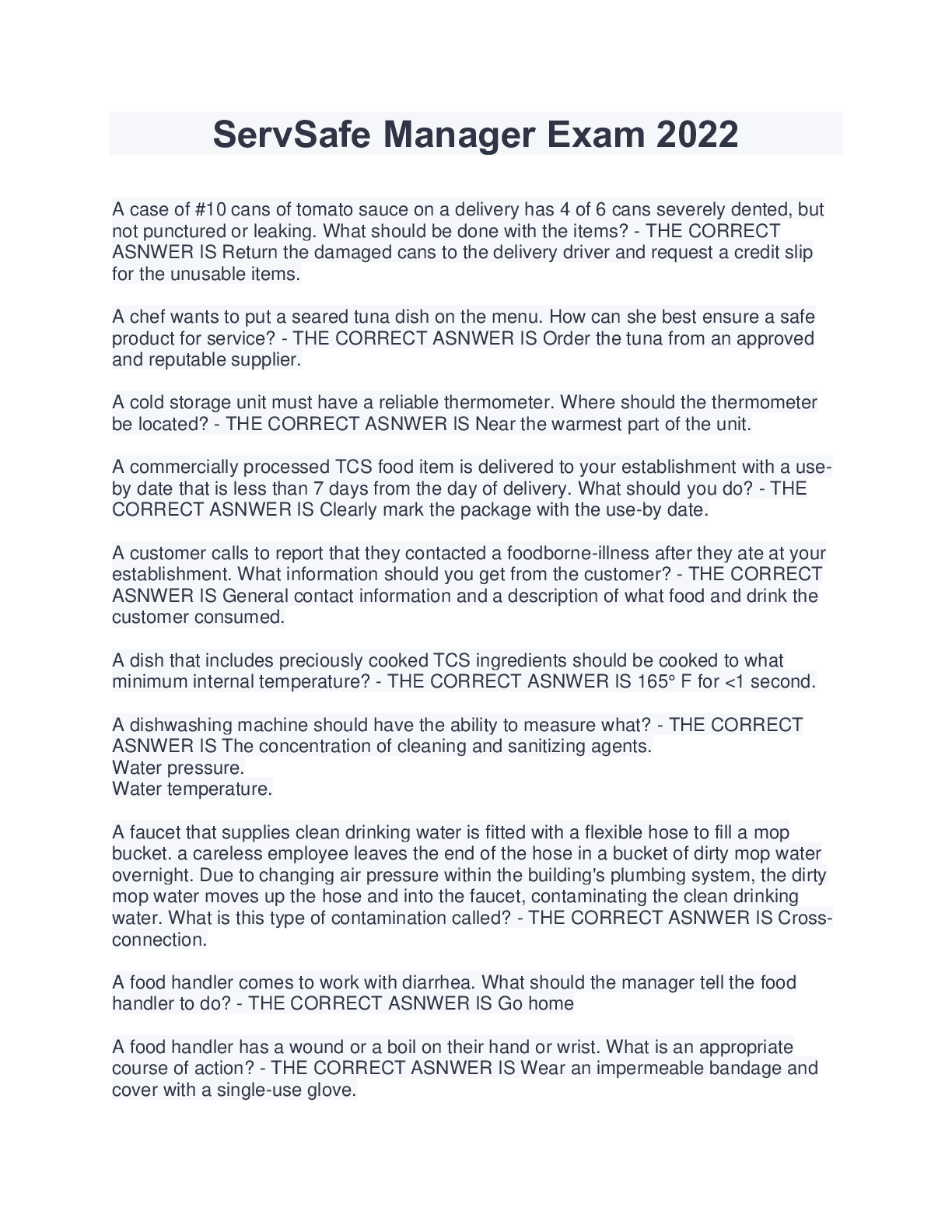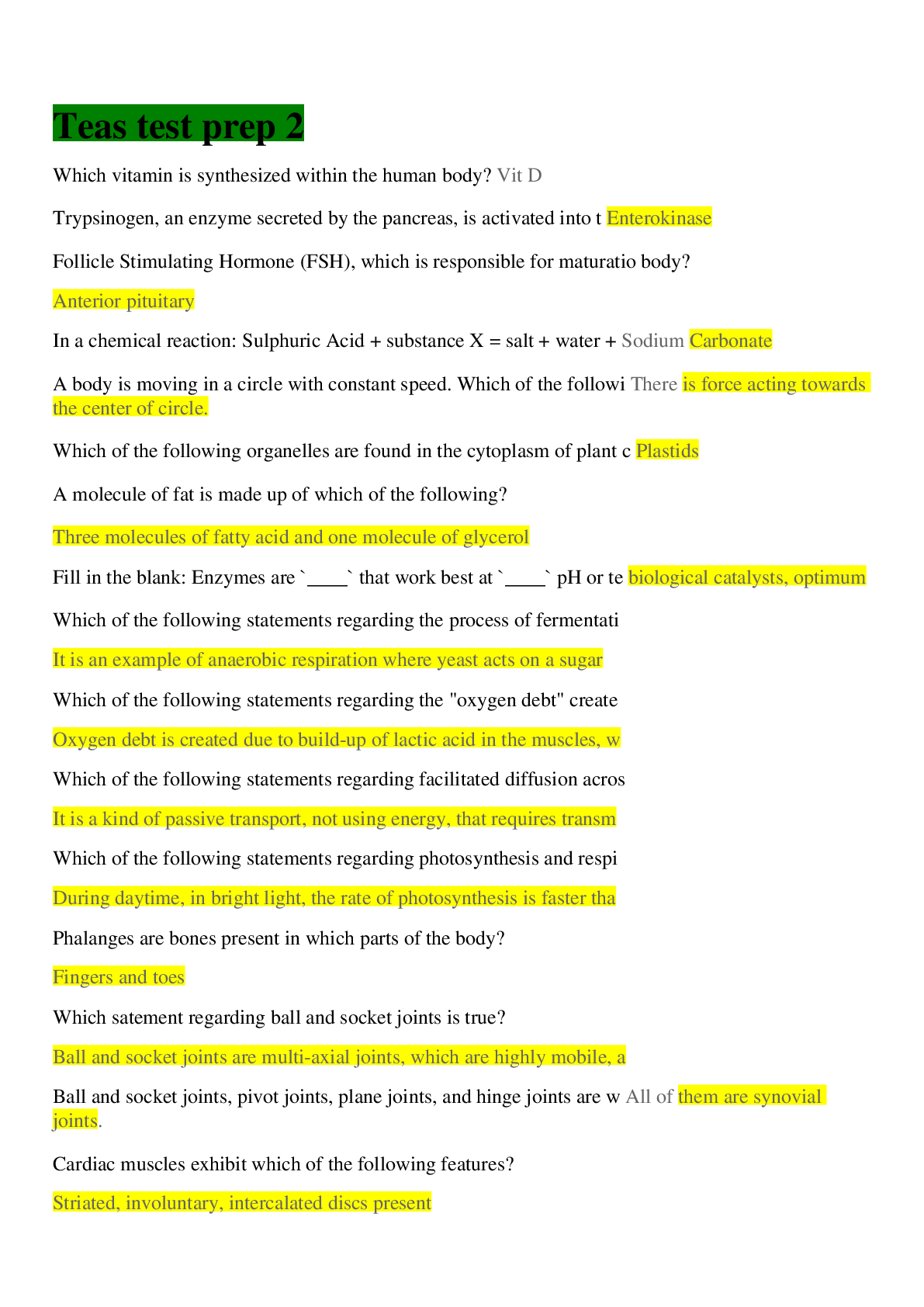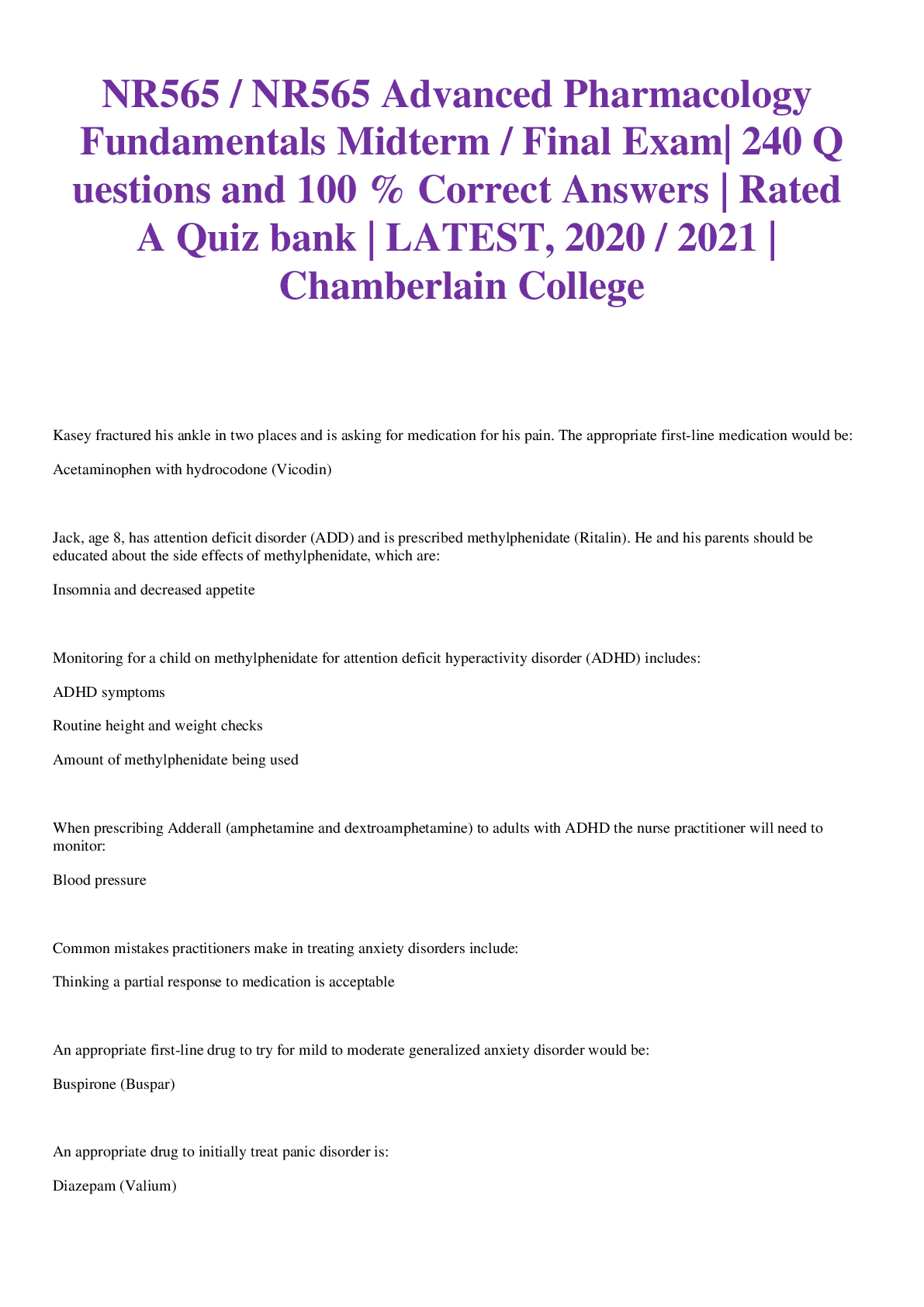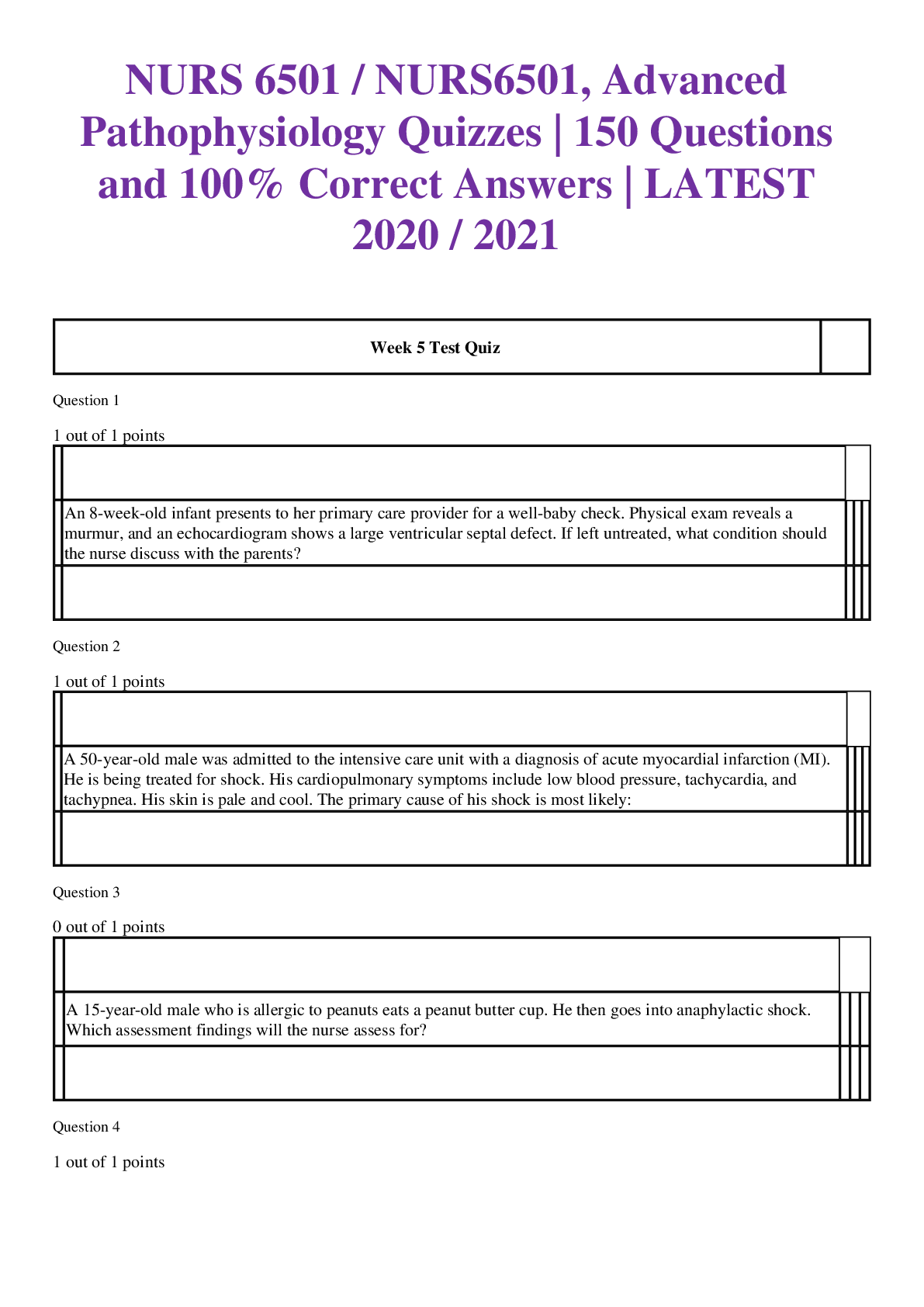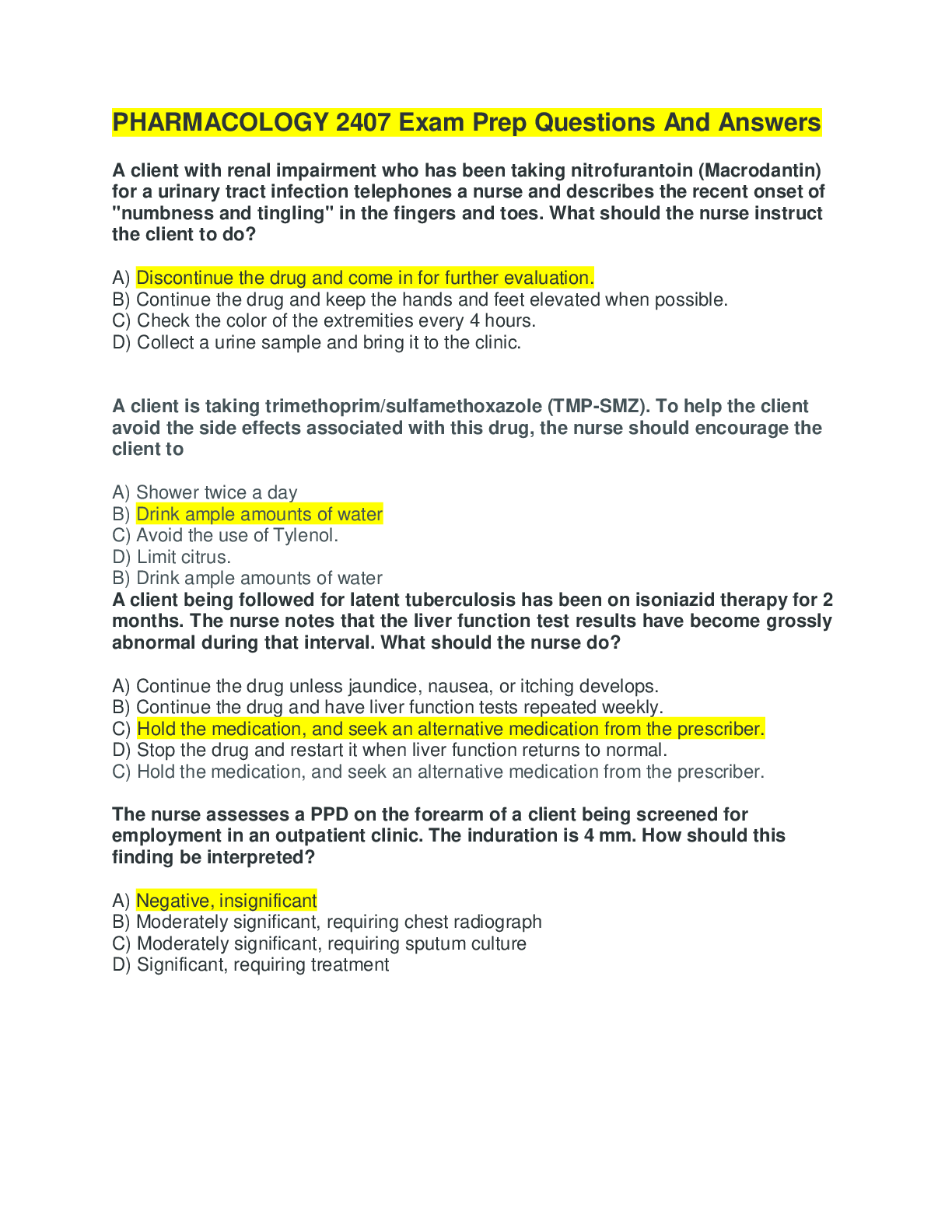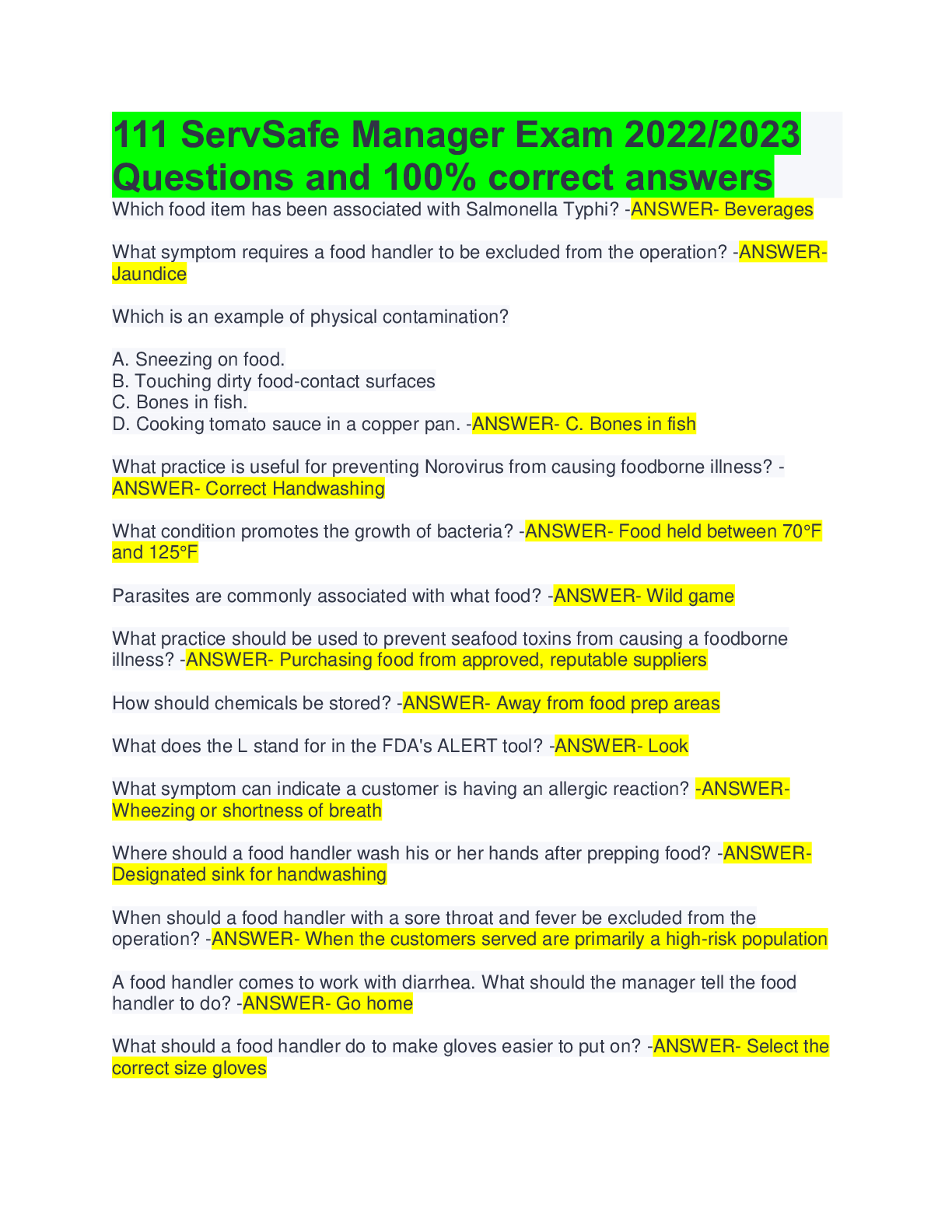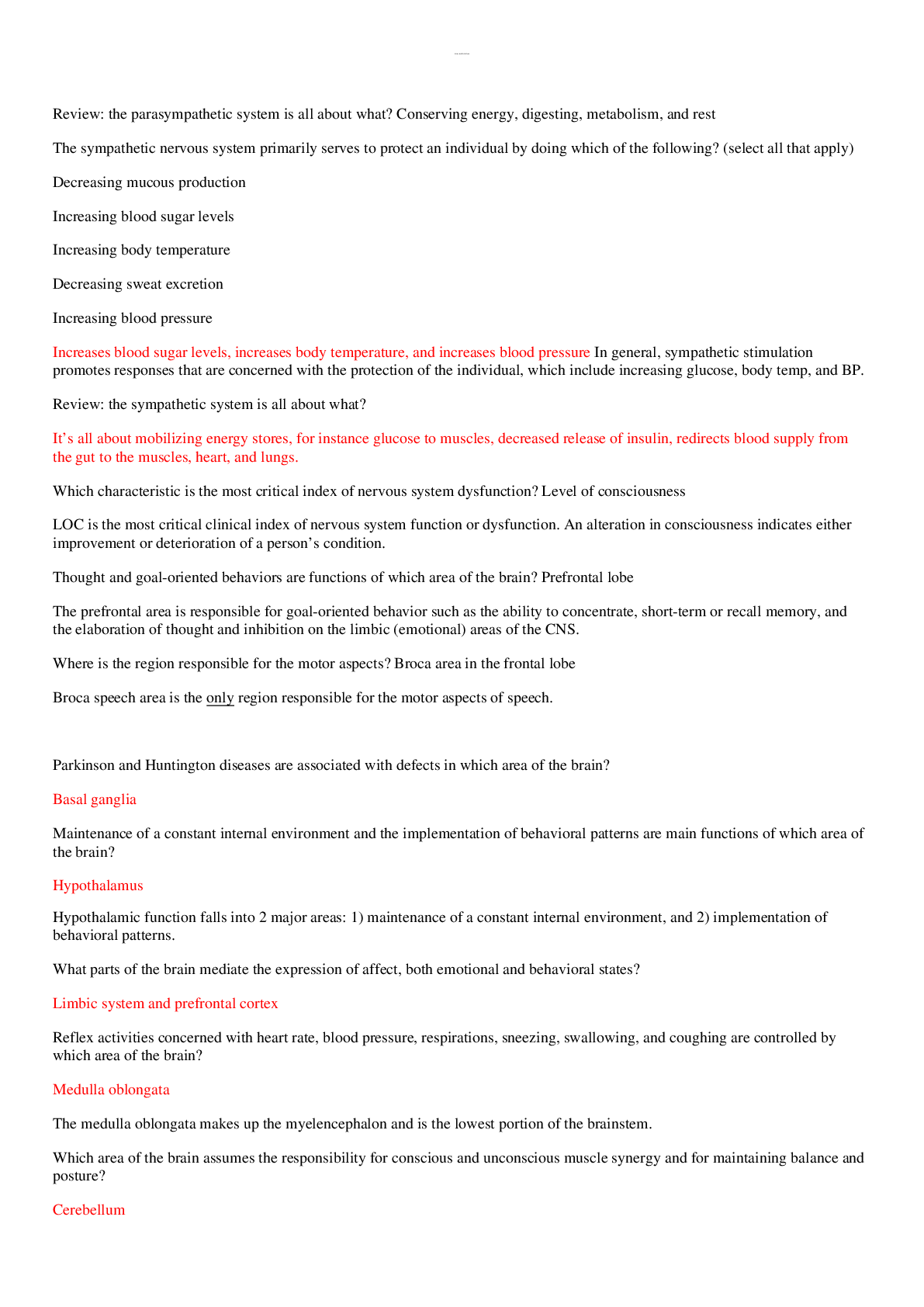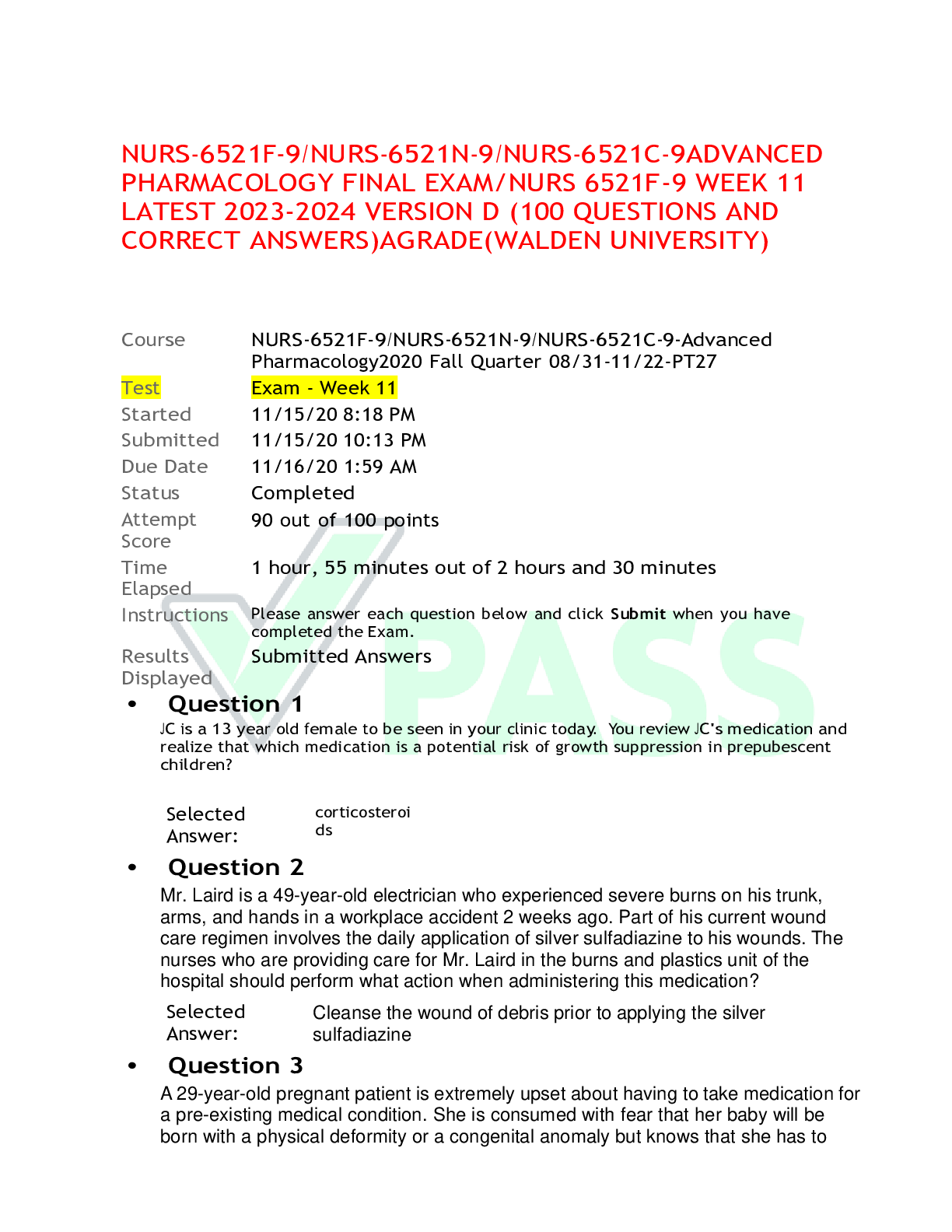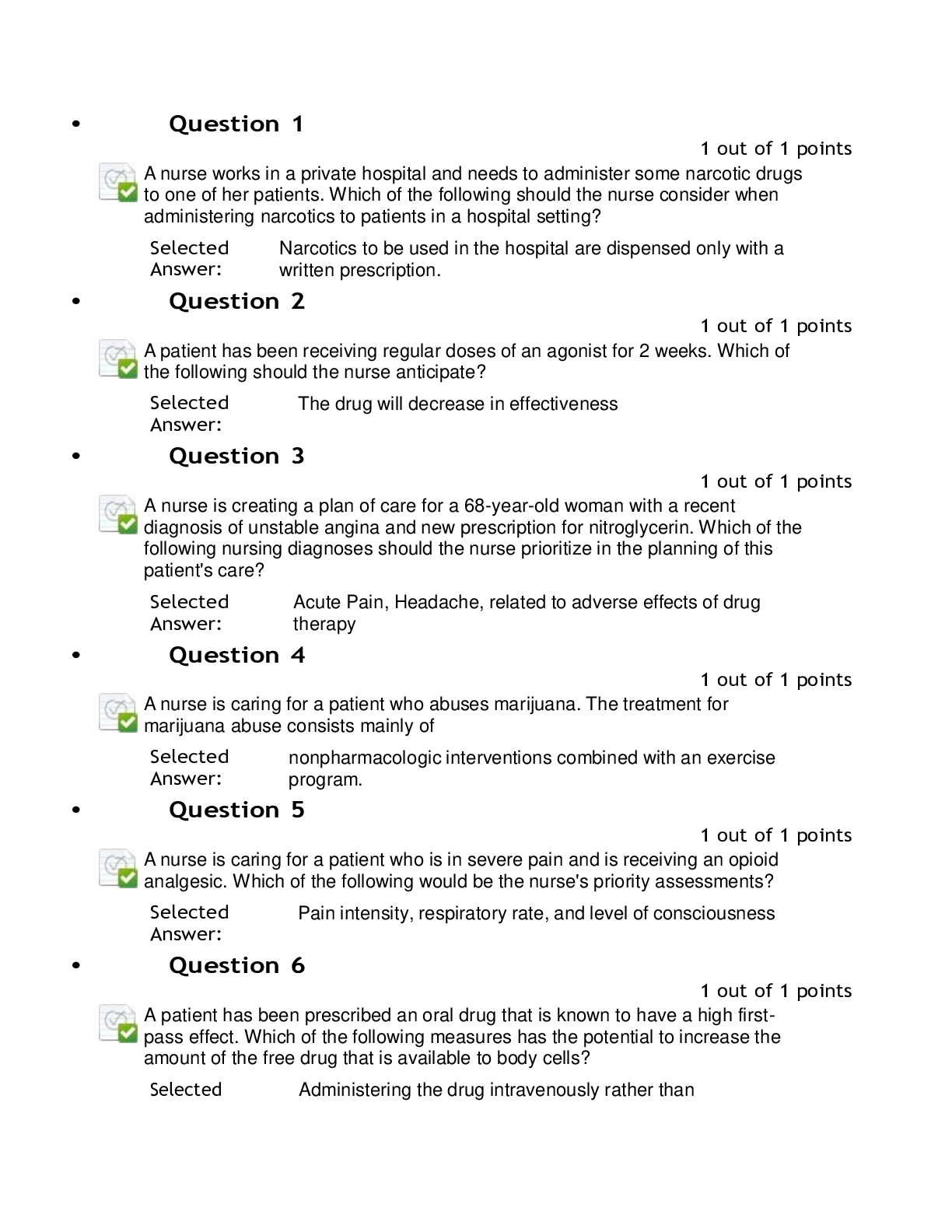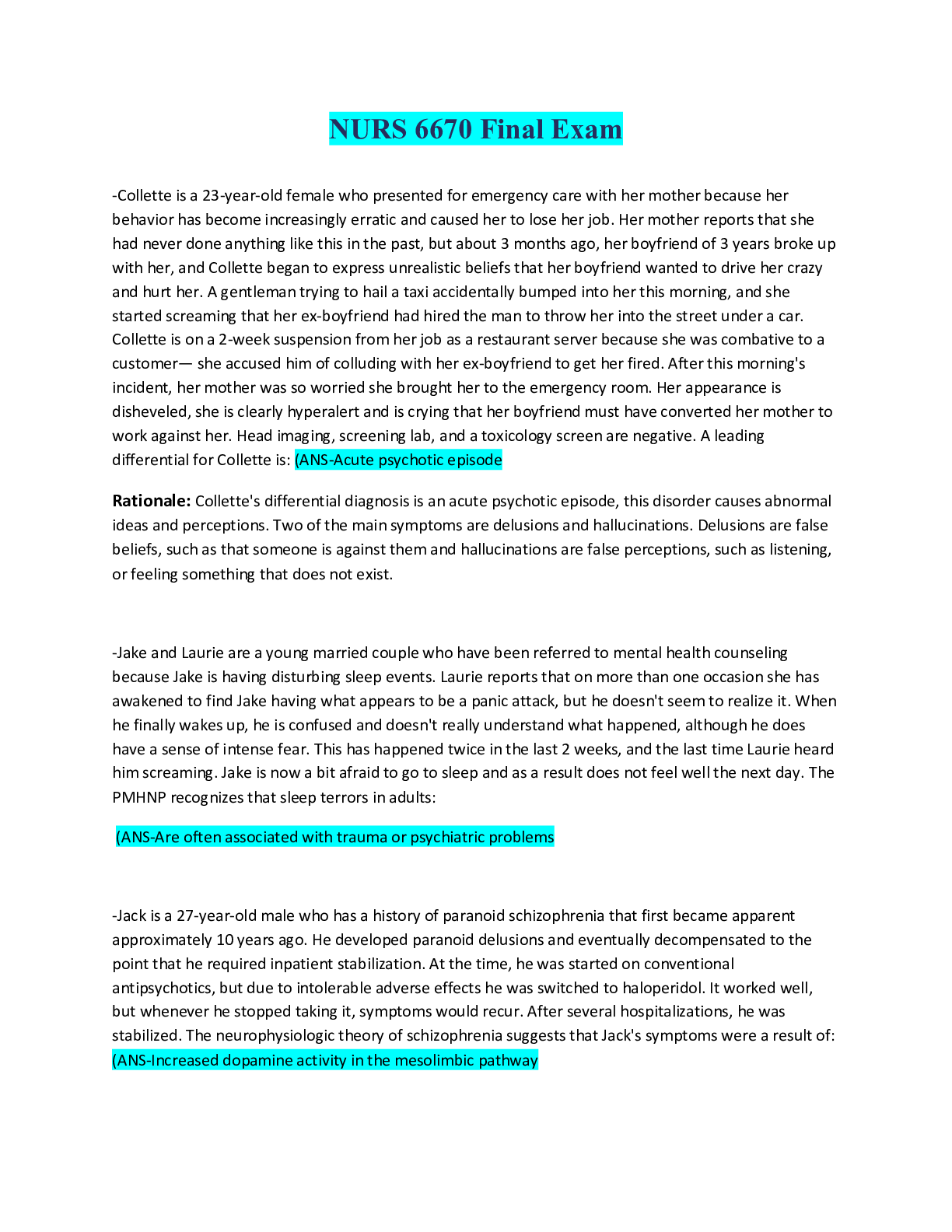Biology > EXAM > Bio 235 Final Exam With Complete Solution(Latest 2022,already graded A ) 222 Questions with 100% Cor (All)
Bio 235 Final Exam With Complete Solution(Latest 2022,already graded A ) 222 Questions with 100% Correct Answers
Document Content and Description Below
Venous blood returning from systemic circulation first enters the ___, proceeds to the ____, loses ___and gains ____ in the lungs, and then returns to the heart via the ____. a) right atrium, right ... ventricle, pulmonary artery, CO2, O2, pulmonary veins. b) Left atrium, left ventricle, pulmonary artery, CO2, O2, aorta c)Right atrium, right ventricle, pulmonary artery, O2, CO2, pulmonary veins d) Left atrium, right ventricle, pulmonary veins, O2, CO2, aorta - ✔✔A. Right atrium, right ventricle, pulmonary artery, CO2, O2, pulmonary veins The upper respiratory tract differs from the lower respiratory tract in what way? A) air is taken in through the lower respiratory tract, and CO2/O2 are exchanged in the upper respiratory tract b) air is taken in through the upper respiratory tract, and CO2/O2 are exchanged in the lower respiratory tract c) CO2 is removed from circulation in the upper respiratory tract d) O2 is removed from circulation in the lower respiratory tract - ✔✔B. Air is taken in through the upper respiratory tract, and CO2/O2 are exchanged in the lower respiratory tract Smooth muscle surrounds which structure of the lower respiratory tract? a) Alveoli b) Alveolar capillaries c) Terminal bronchioles d) Trachea - ✔✔C. terminal bronchioles In the alveolus, ____squamous epithelial cells are responsible for ___, while ___cells are responsible for ____. a) Type 1; surfactant secretion; Type 2, gas exchange b) type 1; debris removal; type 2; surfactant secretionc) type 3; debris removal; type 1; gas exchange d) type 1; gas exchange; type 2: surfactant secretion - ✔✔d) type 1; gas exchange; type 2: surfactant secretion There is no net air flow into or out of the lungs when a) P alveolus = P atmostpher b) P alveolus< P atmostphere c) P pleural wall > P atmostphere d) P atmosphere< P pleural wall - ✔✔a) P alveolus = P atmosphere What keeps the lungs from collapsing Check the - ✔✔b) trans pulmonary negative pressure caused by negative pressure from pleural cavity Identify the correct sequence of events for inspiration a) diaphragm & inspiratory intercostals relax, lungs expand, air flows into alveoli b) diaphragm & inspiratory intercostals contract; lungs expand, air flows out of the alveoli c) diaphragm & inspiratory intercostals contract, lungs expand, air flows into alveoli d)diaphragm & expiratory intercostals relax, lungs contract, air flows out of alveoli - ✔✔c) diaphragm & inspiratory intercostals contract, lungs expand, air flows into alveoli the main determiners of lung compliance are a) lung tissue thickness, surface tension of fluid on the inner lung surface b) lung tissue perforations, surface tension of fluid on the inner lung surface c) lung tissue surface area, surface tension of fluid on the inner lung surface d) lung tissue thickness, surface tension of fluid on the outer lung surface - ✔✔a) lung tissue thickness, surface tension of fluid on the inner lung surface lung compliance is defined asa) lung volume/ transpulmonary pressure b) transpulmonary pressure/ lung volume c) transthoracic pressure/ atmospheric pressure d) none of the above - ✔✔d) none of the above trained athletes tend to have a) increased lung compliance b) normal lung compliance c) decreased lung compliance d) asthma - ✔✔a) increased lung compliance which is true abbout the pleural sac a)it is continuous with the atmosphere and protects the lungs from infections b) it is a closed sac surrounding each lung and contains only a tiny volume of lubricating fluid c) it is a closed sac surrounding each lung and contain a large volume of surfactact d) it is a closed, air-filled space surrounding both lungs that has a negative pressure compared to atmospheric pressure - ✔✔b) it is a closed sac surrounding each lung and contains only a tiny volume of lubricating fluid which structure is NOT part of the "anatomical dead space?" a) bronchiole b) trachea c) bronchus d)respiratory bronchiole - ✔✔d)respiratory bronchiole the volume of air flowing into the alveoli during inhalation/inspiration is increased when there is an increase in which of these? a)air resistance b)the pressure gradiant from the atmosphere to the alveoli c) the pressure in the intrapleural spaced) the curvature of the diaphragm - ✔✔b)the pressure gradiant from the atmosphere to the alveoli under normal circumstances, which of the following would result from an increase in transpulmonary pressure? a) inhalation/inspiration b) exhalation/expiration c) a collapsed lung d) emphysema - ✔✔a) inhalation/inspiration which of the following statements about the response of arteriole smooth muscle to changing ocygen partial pressure is true? a) both systemic and pulmonary arterioles respond to a decrease in PO2 by constricting b) both systemic and pulmonary arterioles respond to a decrease in PO2 by dilating c) systemic arterioles respond to a decrease in PO2 by dilating but pulmonary arterioles constrict in response to decreased PO d) systemic arterioles respond to a decrease in PO2 by constricting but pulmonary arterioles dilate in response to decreased PO2 - ✔✔c) systemic arterioles respond to a decrease in PO2 by dilating but pulmonary arterioles constrict in response to decreased PO during an unforced exhalation/expiration, which would NOT be true? a) alveolar pressure is greater than atmospheric pressure b) intrapleural pressure is greater than alveolar pressure c) intrapleural pressure becomes less negative d) the diaphragm relaxes - ✔✔b) intrapleural pressure is greater than alveolar pressure which true regarding how gases dissolve in liquids? a0 the concentration of a gas in a liquid equilibrates to match the concentration of that gas in the air to which of the liquid is exposed b) different gasses have the same solubility in liquids c) the partial pressure of a gas in a liquid is equal to the amount greatly diffusing in the liquid plus the amount bound to large molecules within the liquidd) the partial pressure of a particular gas in a liquid equilibrates to match the partial pressure o that gas in the air to which the liquid is exposed - ✔✔d) the partial pressure of a particular gas in a liquid equilibrates to match the partial pressure o that gas in the air to which the liquid is exposed which of these results from hyperventilation? a) increased alveolar PCO2 and decreased alveolar PO2 b) an increase in both PO2 & PO2 c) decreased alveolar PCO2 & increased alveolar PO2 d) a decrease in both alveolar PCO2 & PO2 - ✔✔c) decreased alveolar PCO2 & increased alveolar PO2 In which form is most of the oxygen carried in arterial blood? a) bound to hemoglobin b) dissolved in the plasma c) dissolved in the cytosol of erthrocytes d) converted to HCO3 - ✔✔a) bound to hemoglobin after CO2 is produced by tissues, in what form is most of that carbon transported th the lungs for removal from the body? a) as dissolved CO2 b) found to hemoglobin c) as H2CO3 d) as dissolved HCO3 - ✔✔d) as dissolved HCO3 action potential in neurnos in the inspiratory center of the medulla result in ation potentials in the ____nerves to the diaphragm, which in turn cause ___ of the muscle, resulting in a/an____ in the volume of teh thoiracic cage. a) motor, contraction, decrease b? parasympathetic, contration, decrease c) sympathetic, contraction, increase D) motor, contraction, increase - ✔✔D) motor, contraction, increasewhich is NOT a function of the kidneys in maintin homeostaisis? a) regulation of extracellular fluid osmolarity b) regulation of blood hydrogen ion concentration c) regulation of blood glucose concentration d) regulation of extracellular fluid volume - ✔✔c) regulation of blood glucose concentration which of the following does NOT correctly describe kidney function? a) they contribute significantly to long term regulation of arterial blood pressure by maintaining the proper plasma volume b) they produce urine of a constant composition at all time, in order to maintain homeostasis of extra cellular fluid c) they excrete metabolic waste products d) the assist in maintaing proper acid base balance in the body - ✔✔c) they excrete metabolic waste products the amount of a substance that is excreted in the urine is equal to the amount that is ___ plus the amount that is ___ minus the amount that is ____. a) filtered, reabsorbed, secreted b) reabsorbed, filtered, secreted c) secreted, reabsorbed, filtered d) filtered, secreted, reabsorbed - ✔✔d) filtered, secreted, reabsorbed which is TRUE about the juxtaglomerular apparatus? a) it is composed of parts of the ascending limb of the loop of Henle and the efferent arteriole b) it is composed of glomerular capillaries and the macula densa c) it is the site of renin secretion d) it is created by the junction between the proximal tubule and the afferent arteriole - ✔✔C. It is the site of renin secretion.which correctly describes the composition of the gomerular filtrate d) it is highly similar to plasma, except it doe s not contain plasma proteins - ✔✔D. It is highly similar to plasma, except it does not contain plasma proteins. constriction of the ____decreased hydro-static pressure in ____. a) afferent arterioles, glomerular capillaries b) efferent arterioles, proximal convoluted tubules c) renal vein, peritubular capillaries d) efferent arterioles, glomerular capillaries - ✔✔A. afferent arterioles, glomerular capillaries which is true for a man who is in balance for total bdy water? a) he must ingest more water than is lost in the urine b) he must ingest more water than is lost by all output pathways combined c) he must ingest less water than is lost in the urine d) the water filtered into Bowmans capsule must be 100% reabsorbed - ✔✔a) he must ingest more water than is lost in the urine where do Na/KATPase pumps play an active role in reabsorbing Na? a) in bowmans capsule epithelial cells, facing the interior of Bowmans space b) in the basolateral membrane of cells of thr cortical collecting ducts c) in the apical membrane of epithelial cells of the proximal tubule d) in the luminal membrane of epithelial cells of the distal convoluted tubule - ✔✔b) in the basolateral membrane of cells of thr cortical collecting ducts In the condition diabetes mellitus, why does glucose appear in the urine? A) the plasma concentration of glucosr becomes so high that it diffuses from peritubulat capillaries into the proximal tubule, down is concentration gradient b) the filtered load glucose becomes greater than the tubular maximum for its reabsorption c) without the hormone insulin, glucose cannot enter proximal tubule epithelial cellsd) the rate of tubular secretion of glucose becomes greater than the sum of glucose filtration and reabsorption - ✔✔b) the filtered load glucose becomes greater than the tubular maximum for its reabsorption Which of the following most accurately describes the renal transport of Na+? A) Na+ is actively transported in all segments of tubule b) primary above transport of Ba+ allows for secondary active transport of glucose and H+ in the proximal tubule c) most of the Na+ transport occurs in the distal convoluted tubule and collecting ducts d) Na+ is actively severed into the Neptune lumen by cells in the cortical collecting ducts - ✔✔b) primary above transport of Ba+ allows for secondary active transport of glucose and H+ in the proximal tubule Where does Na+ re absorption NOT occur a) in the ascending limb of the loop of Henle b) in the descending limb of loop of Henle c) in the proximal convoluted tubule d) in the nephron - ✔✔b) in the descending limb of loop of Henle Na+ entry in proximal tubule cells is mainly medicated by_, while in the cortical collecting duct it is mainly medicated by _: A) channels; transporters b) passive diffusion; active diffusion c) transporters; channels d) all entry is mediated by leak channels - ✔✔c) transporters; channels An increase in vasopressin (ADH) triggers what event: a) insertion of AQP2 into the apical membrane of the ruble epithelial cell b) insertion of AQP3 & AQP4 into the apical membrane of the tubule epithelial cell c) removal of AQP2 from the apical membrane of the tubule epithelial cell d) insertion of AQP2 into the Ballarat membrane of the tubule - ✔✔a) insertion of AQP2 into the apical membrane of the ruble epithelial cell [Show More]
Last updated: 1 year ago
Preview 1 out of 41 pages
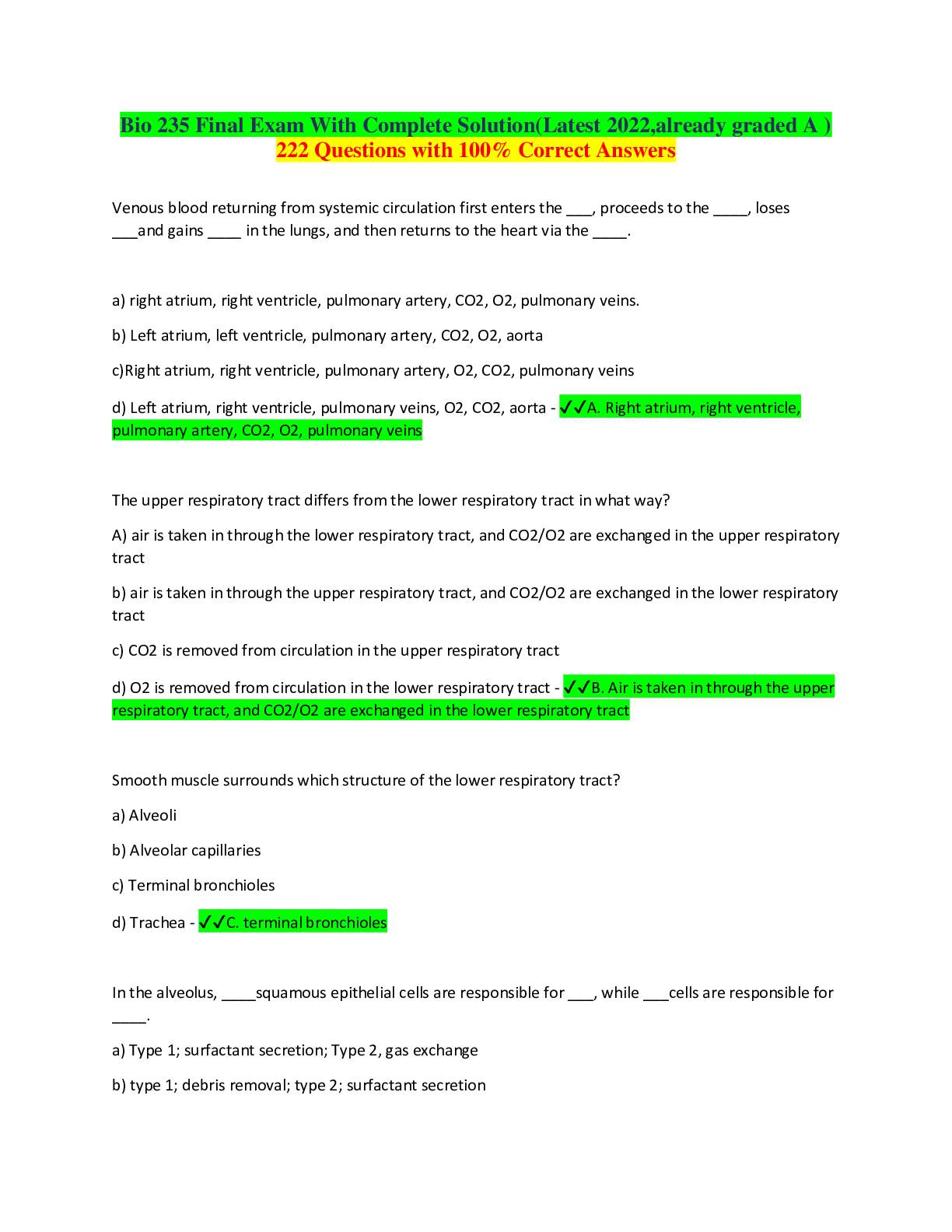
Reviews( 0 )
Document information
Connected school, study & course
About the document
Uploaded On
May 12, 2022
Number of pages
41
Written in
Additional information
This document has been written for:
Uploaded
May 12, 2022
Downloads
2
Views
110

